
Giancarlo Pedote rounded bow

Scow bows – more righting moment and better downwind speed
When the Mini Transat sent out a media release about some new designs for this year's race, we looked at the ugly scow bow in the picture and asked “why?”. Fortunatey, our readers include designers and naval architects, some of whom replied.
Dario Valenza is Australian Sailing + Yachting 's technical contributor and runs Carbonic Boats, which makes an interesting A Class and also produces other high-tech design elements. See more at www.carbonicboats.com . Dario writes:
The short answer is more righting moment, both across the boat and longitudinally. For a given overall beam and keel weight, a scow bow gives more volume away from the centreline as well as more volume ahead of the centre of gravity.
Instead of only having outboard volume from the middle of the boat to the transom as on a pointy boat, with a scow you have it all the way along. This means that the centre of buoyancy moves outboard further when you heel, giving a higher metacentre, or more leverage for the keel and boat mass to exert righting moment.
If sail area is unrestricted, more righting moment means you can carry more sail for a given windspeed. Similarly, downwind you can press harder without burying the nose.
The above only considers hydrostatics. When you look at the dynamic situation, the scow also gives more planing area. But this is secondary since ordinary Minis had no problem planing. Maybe a scow can plane a bit sooner.
Another secondary advantage is that you have more volume for water ballast.
I am not up to speed with the Mini rules, but if they have a static heel limit with ballast loaded, then a scow will get more righting moment from a similar water ballast arrangement to a conventional peer.
The clever thing about a scow is that it obtains the extra righting moment without big changes in trim with heel. You don't get the tendency that wedge-shaped boats have to trim bow-down when heeled. Though recent progress in chined hull design has helped deal pretty effectively with the warping of the waterplane with heel, scows don't have to deal with it at all.
Which brings us to the downsides. The single biggest handicap is additional wetted area when upright. Once powered up the waterline gets narrower, but at zero heel you have a canoe body with disproportionately wide and shallow sections.
A conventional boat can shift weight forward to unstick the transom. A scow is harder to trim and does not have the narrow forward sections of a conventional hull.
Also the blunt bow does give more resistance in some wave conditions and more windage when sailing upwind. Some consideration must also be given to the fact that the keel root is very close to the surface when heeled. Finally, a scow hull uses more material than a conventional one so it will be stiffer but heavier.
In the end the outcome is in great part rule-dependent. The Mini is a short light boat with unrestricted sail area, so adding righting moment usually pays because it allows you to carry more canvas. Some of the extra sail area offsets any drag penalty paid for the extra righting moment. The rest is a net gain.
Another consideration is that with good weather routing, most time on the course can be spent sailing downwind in breeze where the drawbacks of the scow are smaller.
You might be interested to know that RC 10 Raters went through a scow 'trend' in (I think) the 1970s. Possibly around the time the Moths did. http://www.radiosailing.org.au/our past/Frank Russell.pdf . Notably the 10 Rater rule allows you to trade waterline length for sail area.
Also interesting is that the 10 Raters could get away with very low freeboard like the lake scows, but for a different reason: The lake scows sail mainly in flat water but the 10 Raters had no crew to keep dry.
– Dario Valenza
Naval architect Andy Warner also sent us a succinct explanation of the positives for a scow bow:
With a displacement hull the angle that the water is parted with at the bow is an important contributor to resistance of the form along with Displacement, Length, Prismatic Coefficient, position of the Centre of Buoyancy. The bigger the angle the more resistance.
If the hull is not operating at displacement speeds but rather is planing the resistance of the form is governed by a different set of factors. Particularly Length and bow angle are much less of a contributor and beam plays a bigger role. Look at a picture of a powerboat on a plane with the narrower bow lifted clear of the water and a much blunter part just throwing water out to the side.
The boat you have a picture of for the mini transat clearly expects to be planing most of the time.
Likewise if the Sydney Hobart was a race with boats planing from start to finish Comanche would have won but when the wind went a bit lighter or on the nose the narrower Wild Oats had the advantage. Every boat design is a compromise and a balancing act. Extreme boats will always win if they get the right weather
– Andy Warner
And Hugh Spencer contributed these thoughts:

ALSO ON MYSAILING

The comeback king takes the win

Team Nika ahead at halfway stage of 44Cup World Championship Brunnen

Kiwis on top after day 2 of the Louis Vuitton Preliminary Regatta

Women at the top at Hamilton Island Race Week

Edencraft Creative expands with Composites

Paris 2024 Olympians elected to World Sailing Athletes’ Committee

The Yacht Sales Co. Announces Special Dufour Yachts Showcase Event

Concord Ryde Sailing Club season start

AIMEX and Superyacht Australia announces dates for the ASMEX 2025 Conference

Local heroes on Black Star Sailing Team take early lead at Brunnen 44Cup Worlds

Palermo-Montecarlo line honours and record for Black Jack

Hamilton Island Race Week – All Styles and Sizes
Join Our Newsletter
- Name First Last
- Name This field is for validation purposes and should be left unchanged.

Read all of the latest sailing news

Dinghy and Yacht Racing News

News from the offshore world

Cruising Stories from around the world

Boats & Gear
The latest boats and yachting gear

Watch everything sailing and boating
Latest Sailing News, Racing, Cruising, Boats, Gear and more
BoatNews.com
Revolution 24 : A successful version of the aluminum scow bow cruiser
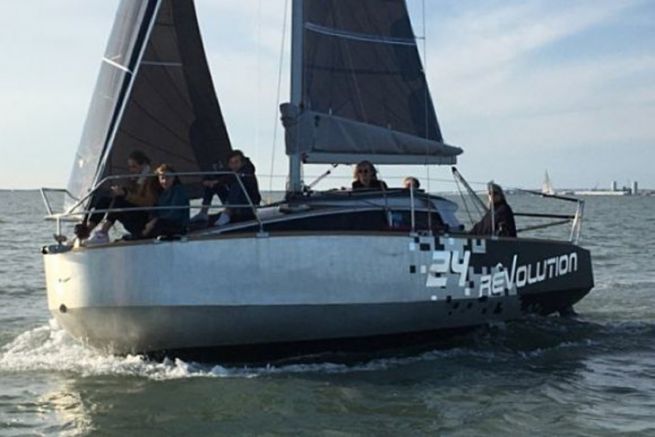
AFEP, a small shipyard based in La Rochelle, was the first to adopt scow hulls for the cruising yachtsman. For its third model, it has found an interesting balance between design, performance and choice of materials. Presentation.
3rd AFEP scow signed Raison
Launched with the Revolution 22 in 2012, the range of scow-bowed sailboats from the AFEP shipyard in La Rochelle continues to expand. Still backed by architect David Raison , renowned for his Mini 6.50s, the builder then developed the Revolution 29, and in 2021 will present the third, intermediate model, the Revolution 24, a 7.25-meter-long, 2.89-meter-wide yacht. The latter continues to benefit from hydrodynamic innovations, while taking advantage of a roof with a more elaborate design than the first born of the range, in line with the elegant 29-footer.
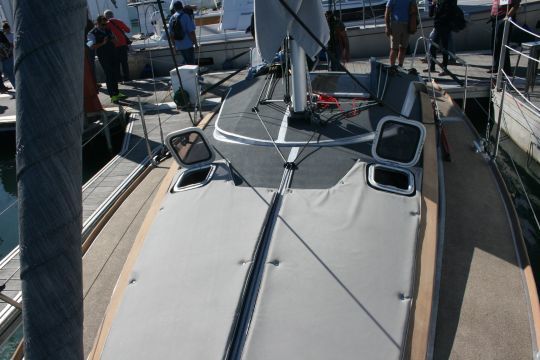
A simple deck and a robust boat
In addition to the aforementioned bow, it is the choice of materials that is striking when you first see the boat . AFEP remains faithful to its favorite material, aluminum. It gives the boat a rustic feel and is solid against impact, while remaining more easily recyclable than composite. The insulation and anti-skidding are made of visible sprayed cork. The resulting empty displacement of the boat is 2,248 kg. The mainsail with horn of 26 m² and the genoa of 17 m² should propel the boat at speeds more than reasonable.
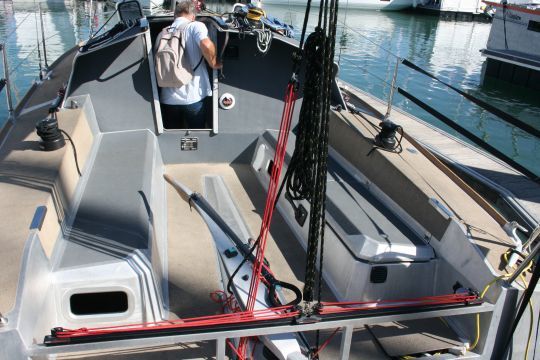
With a tiller, a large cockpit, a fixed central footrest and a single piano winch on the roof, the Revolution 24 plays it simple. The roof cap effectively protects the electronics by avoiding reflections, while adding a touch of elegance. We can regret the tiller rail which does not facilitate access to the small bathing platform, but which secures the cockpit.

The front deck and its impressive surface are a strong argument for the boat at anchor . The cushions, attached to the roof by snaps, invite you to lie down. They also allow to hide the large plexiglass panels, avoiding the greenhouse effect inside the saloon.
Generous cabins and saloon
Going down the 3 slightly narrow steps, one discovers a galley along the port side. There is a sink and two gas cookers on gimbals, as well as a nice worktop and storage .
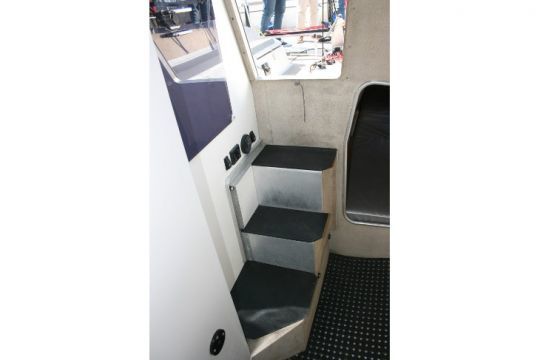
On the aft port side, a large double berth is located under the cockpit.
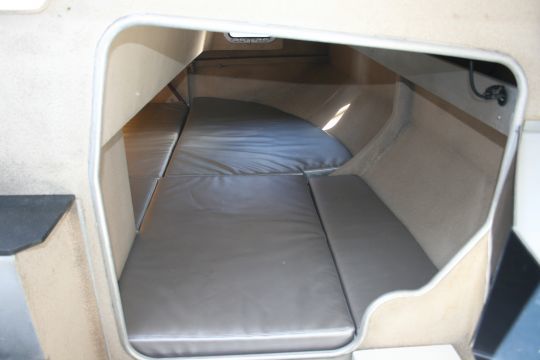
On the bow is the boat's most charming feature: its large saloon, surrounded by equipment and textile storage .
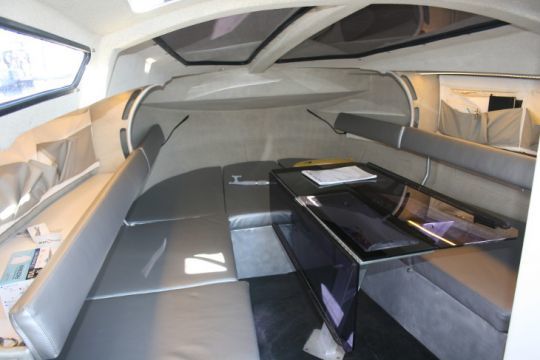
On the starboard side, separated from the axis by the sabre keel well, which allows to pass from 1.90 m to 0.60 m of draught, there is a sanitary space with toilets. A manhole gives access to a technical storage area under the cockpit.
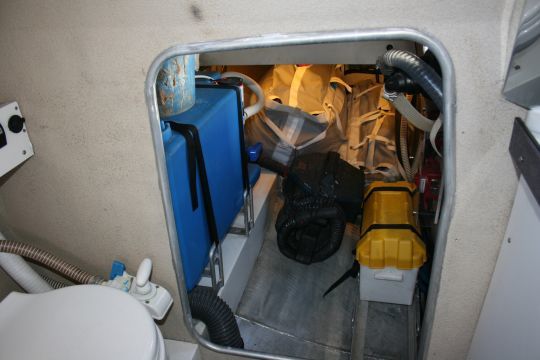
If the choice of the sabre keel partly constrains the layout without allowing to take full advantage of the space, the Revolution 24 nevertheless benefits from a nice interior volume for its size.
The boat is proposed in its basic version at 89 500euros TTC, with an inboard engine of 13 horses.

- AMERICA'S CUP
- CLASSIFIEDS
- NEWSLETTERS
- SUBMIT NEWS

The newest fast 30, by Farr
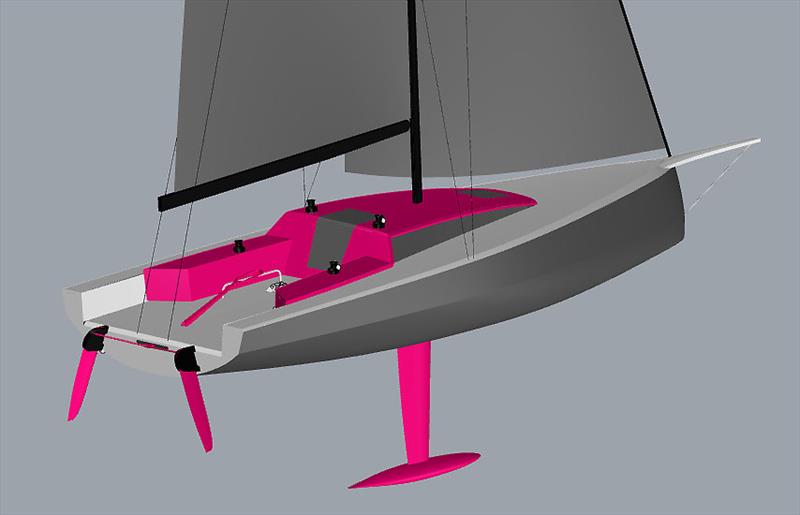
Related Articles
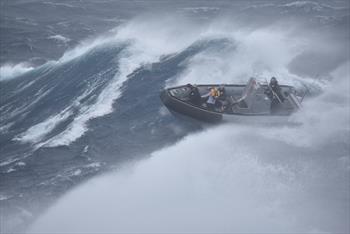

Vector 6.5 Mini Racer
- October 5th, 2022
Upon seeing the apparently brand new boat, I immediately took out my cell phone and called a number: “Could this be your new boat?”, I asked the guy at the other end. “Yepp, she is it!”, confirmed the voice of a young man. If I´d see it to make an article, I went on asking. No problem, assured the man and a day later – sunny sky with dramatic autumn clouds – we met in person. The guy is Hendrick Decker, a tall, blond, energetic, always brightly smiling young lad – the prototype of a surfer´s guys, I shall say.
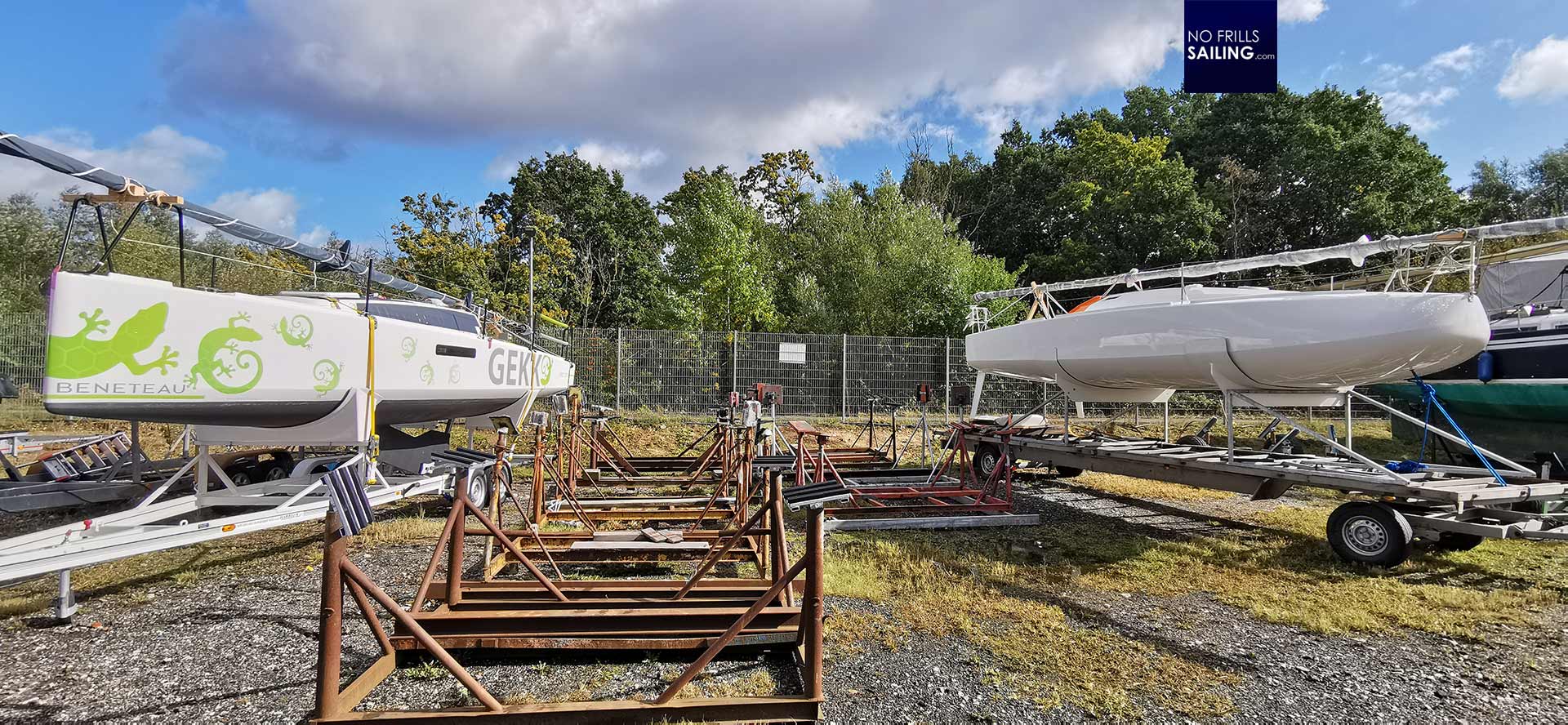
His new boat: A Vector Mini 6.50 racer. Brand new, freshly imported from the yard and parked at the marina , by chance, right next to GEKKO. I was there to fix her on the trailer to make her transport-ready for getting her ack to our yard for completing the last tasks before finally handing her over to her new owners. How lucky am I, have I thought, having this brand new racing boat right next to me. Happy that Hendrick found some time to show me around, I was keen on inspecting how a Classe Mini 6.50 racing boat arrives when newly built.
The Scow-bowed Mini racer
The Vector 6.5 is the latest generation series production Classe Mini 6.50 racer. The boat has been designed by Frenchman Etienne Bertrand in 2017, entering that year´s edition of the Mini Transat race as a prototype, finishing off at an impressive second place. The boat displays latest downwind running optimized hull with an impressive scow bow.
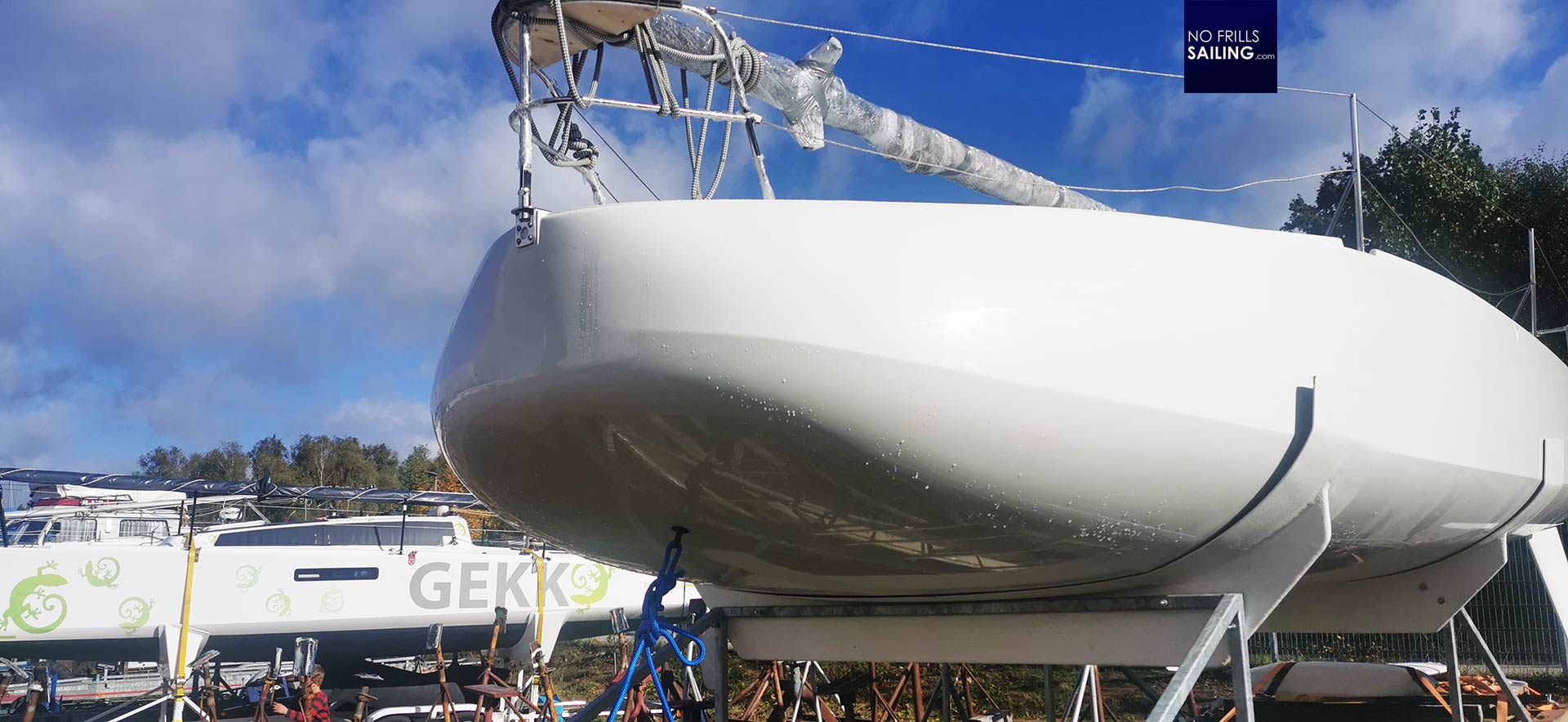
Hendrick smiles brightly as he places a half-emptied bottle of Coce on the trailer: “Yesterday´s regatta celebration went a bit off …”, he smiled half excusatory: “45 knots of wind and a 3 meter wave, it was fun.” Hendrick is a thoroughbred racer. Sailing since he was a small kid, his father´s big cruising boat in a yard´s shed just a few hundred meters away. Hendrick sails races since ever, his old boat, PLAYGIRL, being a used Vector Mini racer, sold months ago: “I am happy to having finally received the new boat”, he reveals: PLAYGIRL 2 is about to be re-located to a shed he rented nearby for finishing.
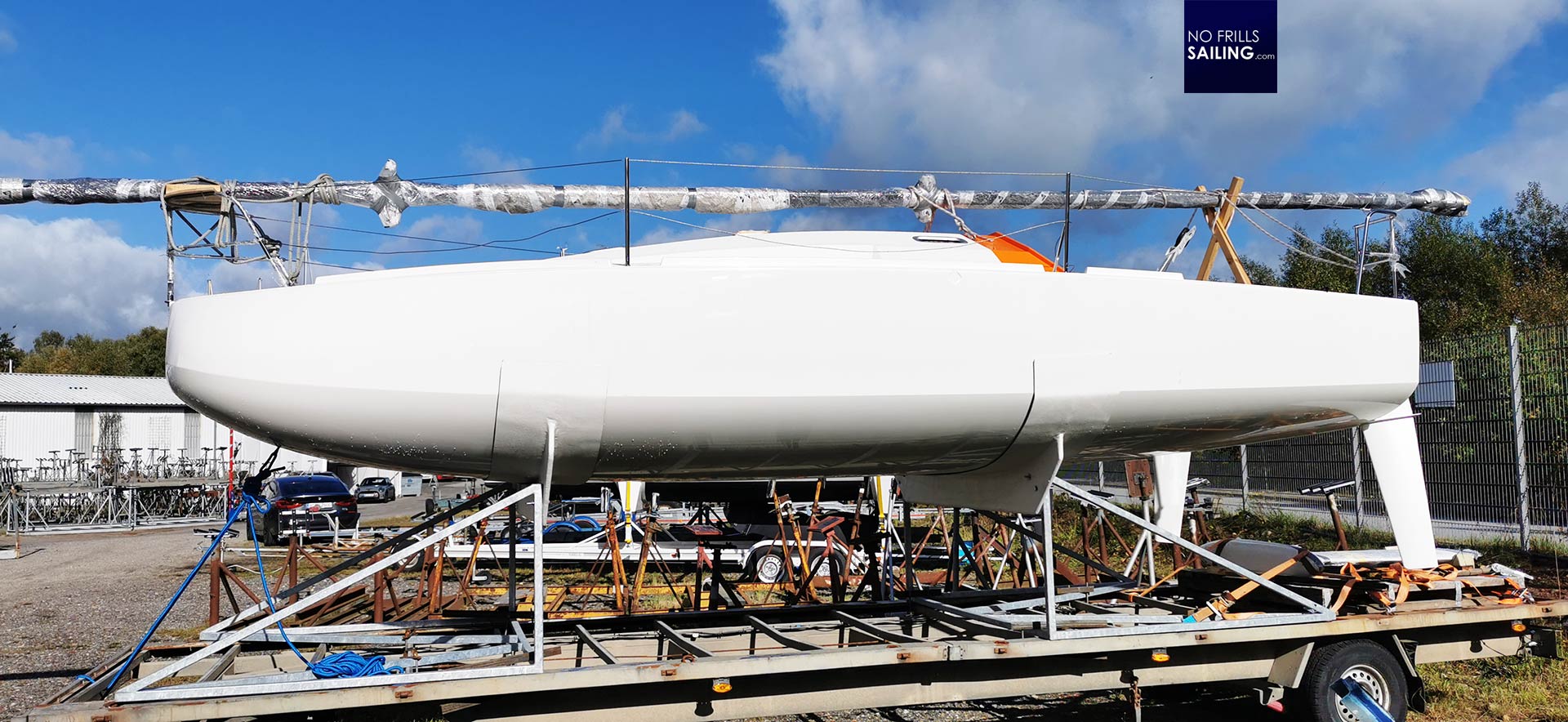
As a Class Mini boat, the box rule of the class dictate measurements and appearance: At 21 feet length the boat must have a minimum freeboard of .75 centimeters and a maximum draft of 2 meters. The rule also dictates, that the mast could not be taller than 12 meters.
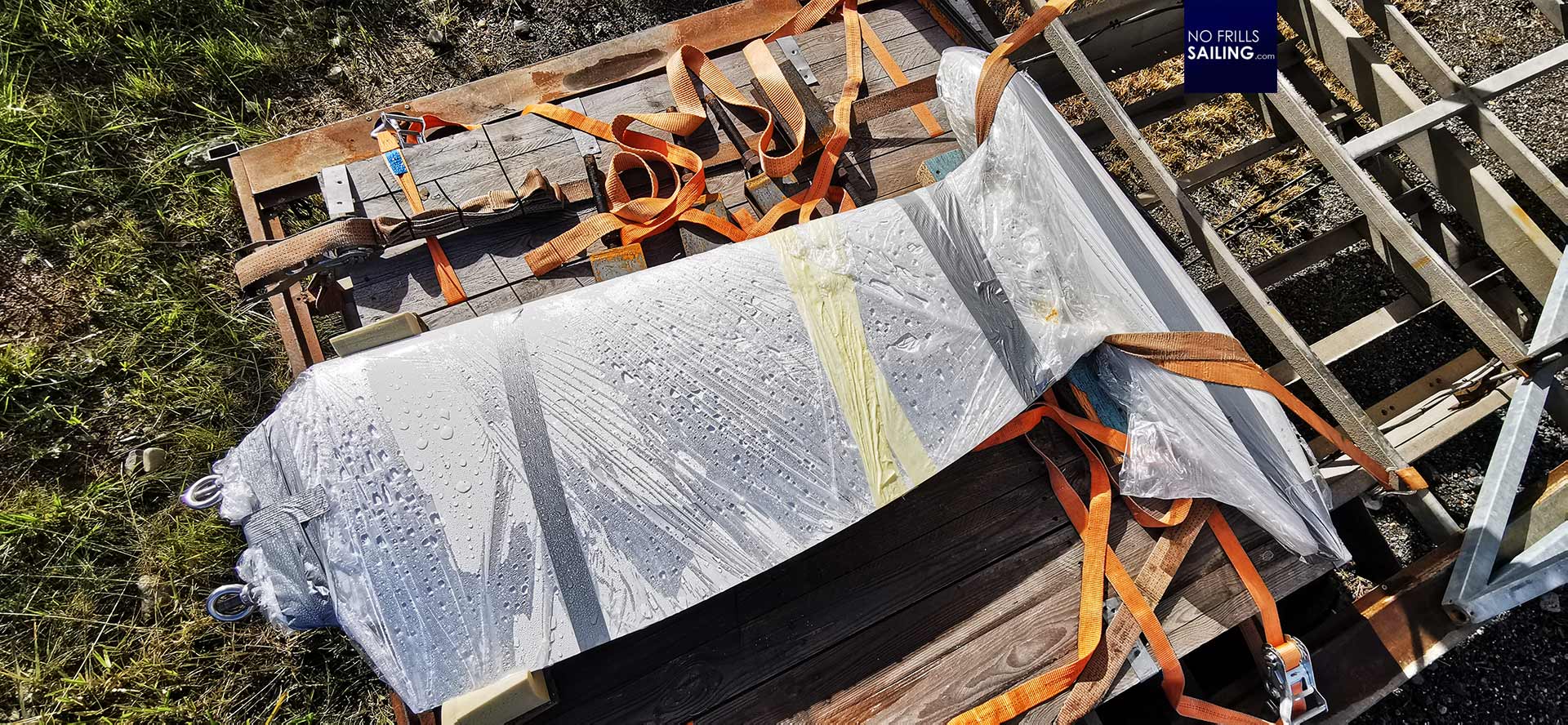
Deep down, still strapped to the improvised trailer, lies the keel. That’s a solid piece of metal: Cast iron fin and a lead T-bulb. Hendrick smiles as I touch the keel: “I am wondering of switching from series boat to prototype”, Hendrick says: “There´s much more possible on these boats, like a canting keel for example.”
Improvements for planning
Nevertheless, even with “only” a series production boat, his new vector 6.5 Mini has some nice improvements over his past boat . He shows a little but interesting detail: The trailing edges of his rudder blades still not “tuned” (like I did on my own boat , he points to a small fin.
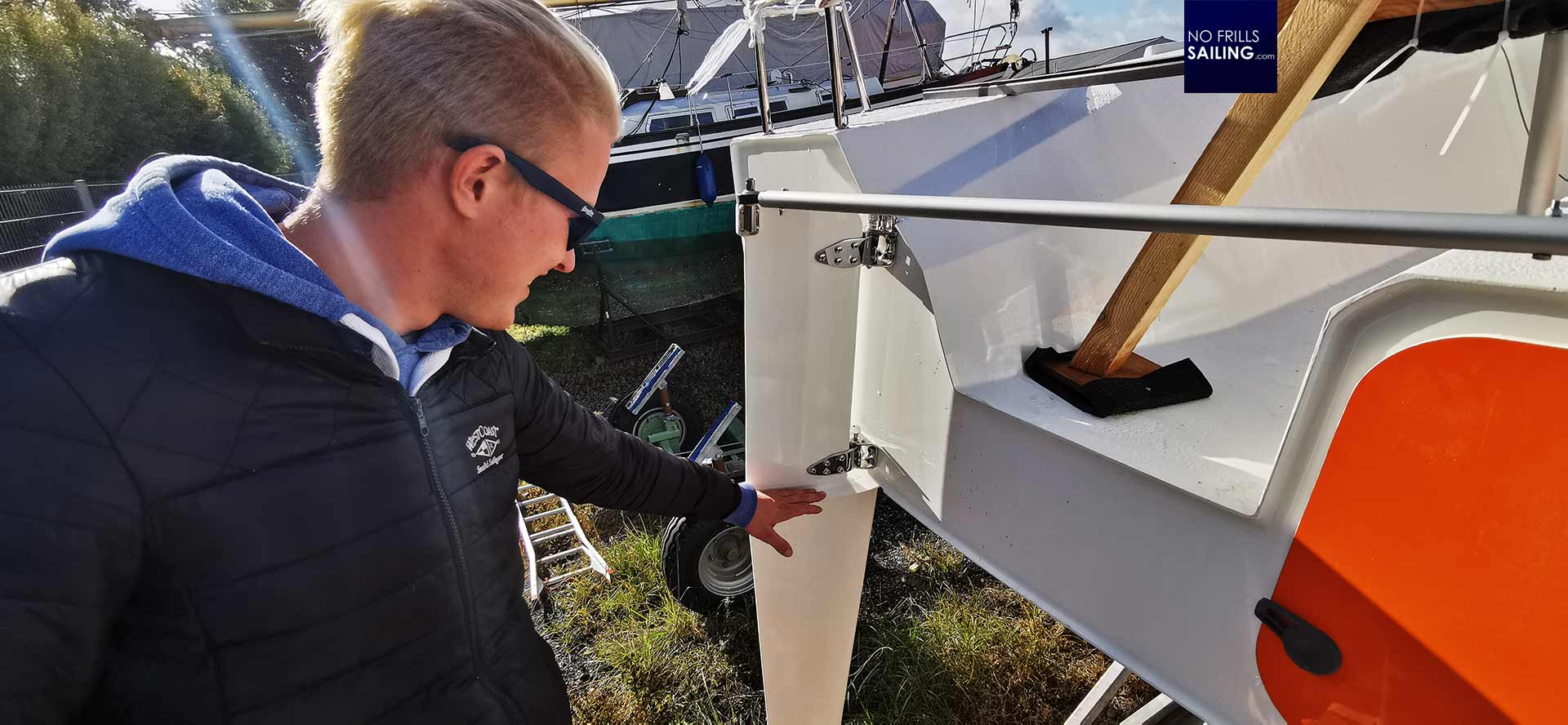
This is new, for example, in this latest version. When planning, it´s the front side of the rudder blade right here where it cuts into the water, where a small wave is created. This wave constantly grabs a firm hold onto the boat´s stern, thus creating some drag that costs speed.
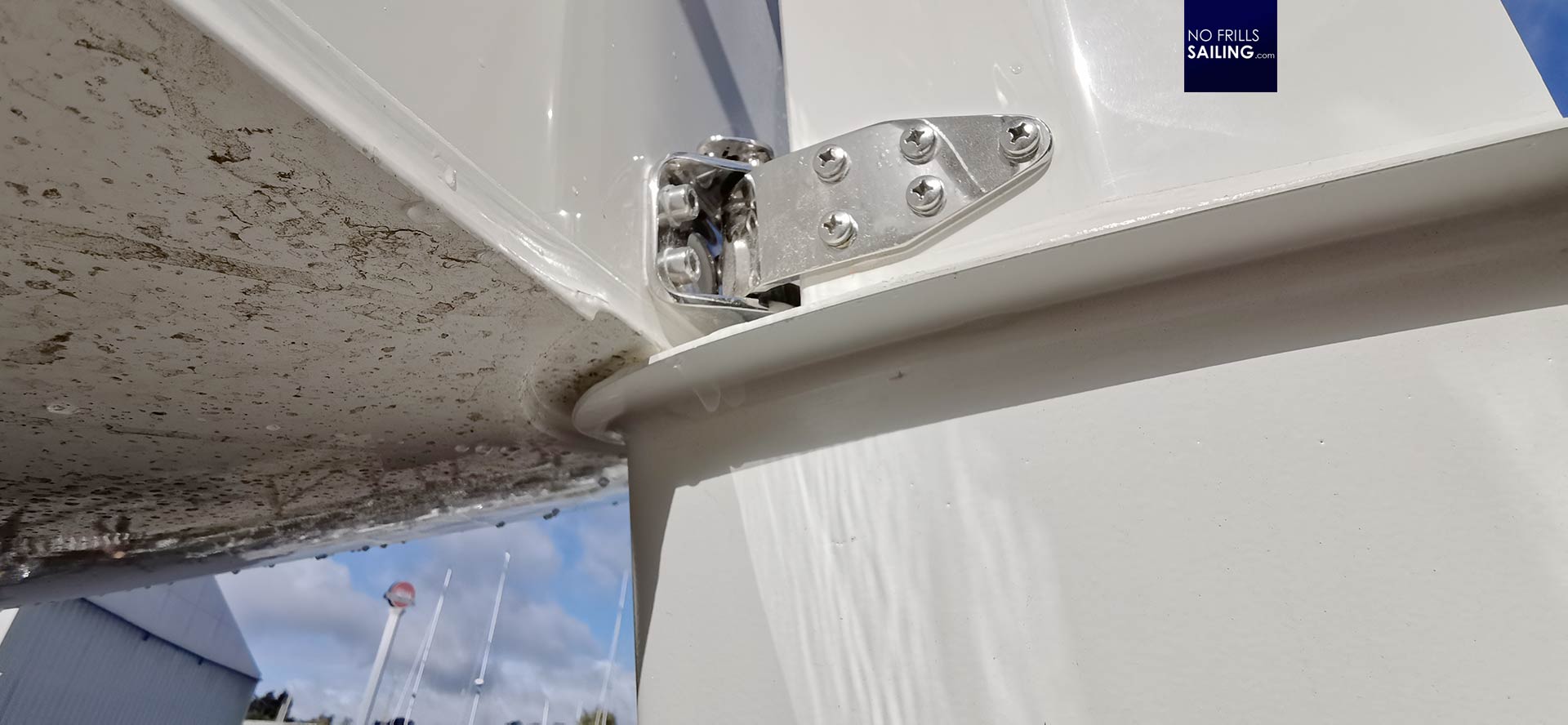
The designer of this boat came up with a small horizontal insert that kind of separates the wet downside of the blades from the stern and is meant to divert the water coming up from the blade to shoot away aft. I find this detail is a great example of what we are talking about here: A serious racing machine meant to wind races. In total, what might be the real net gain of having those small “breaker fins” versus not having them? A hundredth of a knot? But it is the sum of all improvements, every gram spared, every bit of drag reduced, tat makes the difference over hundreds of miles sailed – and hence, the win. Or the loss.
A little big boat
Hendrik climbs on the trailer and into the boat´s cockpit, I follow. The boat is a “Mini” in the closest sense of the word indeed. Six and a half meters is pretty short. Nevertheless, the cockpit itself does not feel all too small, I shall say.
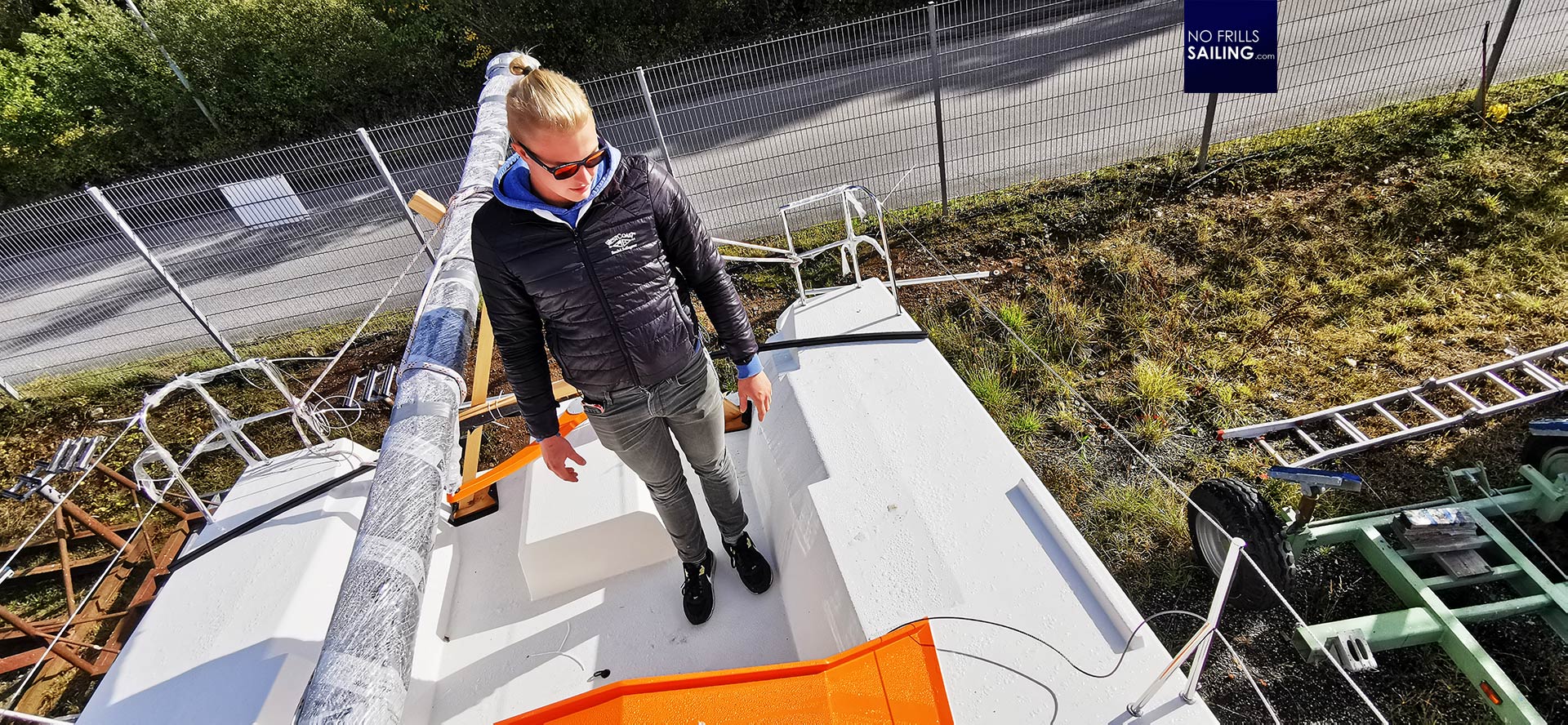
With a width of three meters the Mini is half a meter wider than my old First 27 SE which had a beam of 2.54 m. Even her cockpit felt nice and roomy. I look to the bow and contemplate the enormous area the boat´s deck covers: Since it is a scow bow-boat, it bears much more volume than, let´s say a comparable J-Boat that is much thinner.
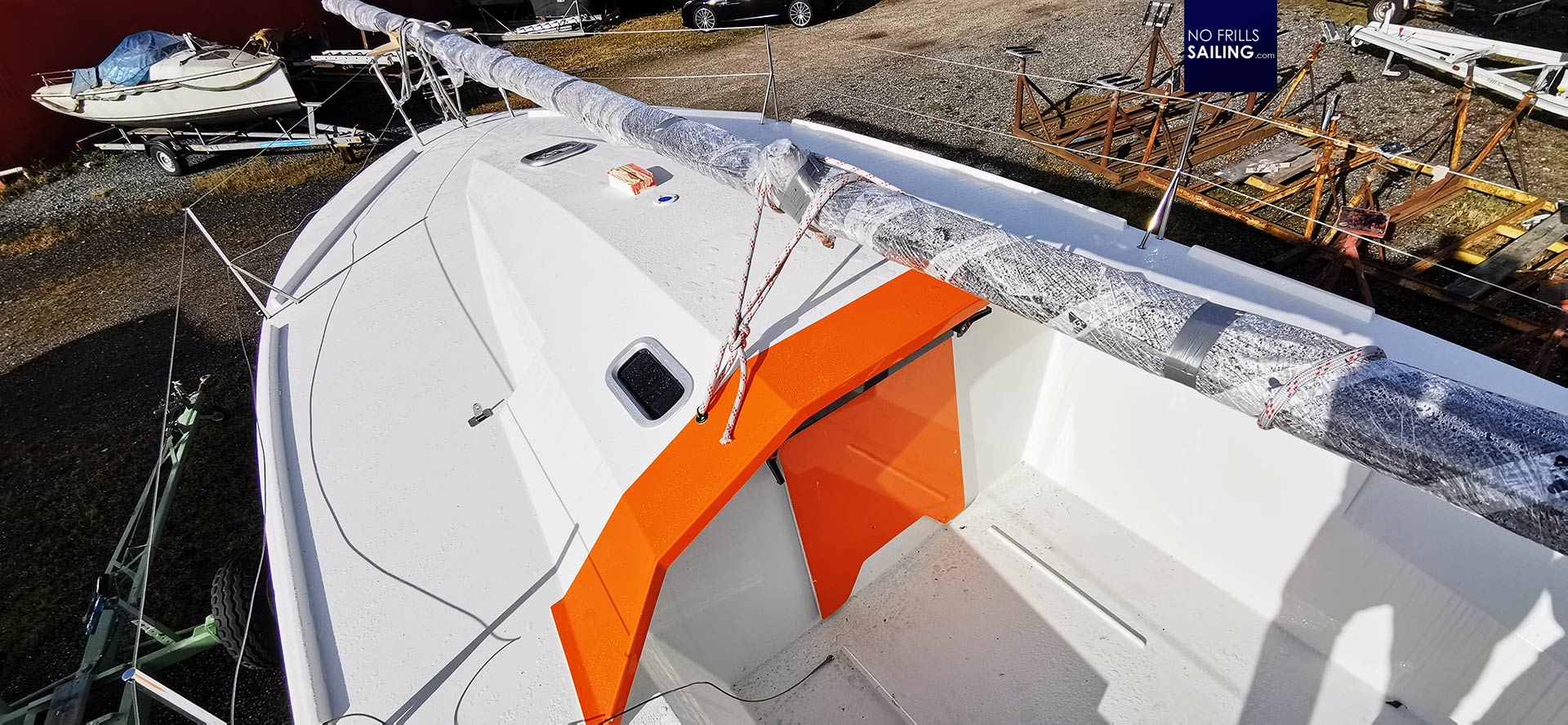
In essence, the Classe Mini-boats is a pure downwind-optimized class. These racing machines are meant to easily take off and start planning mode very early. Upwind sailing capabilities, Hendrik confirms this, are “pretty adventurous”, as he names it. I shall say, these boats are made for reaching points of sail and those alone. Like a giant surf board made to glide above the water.
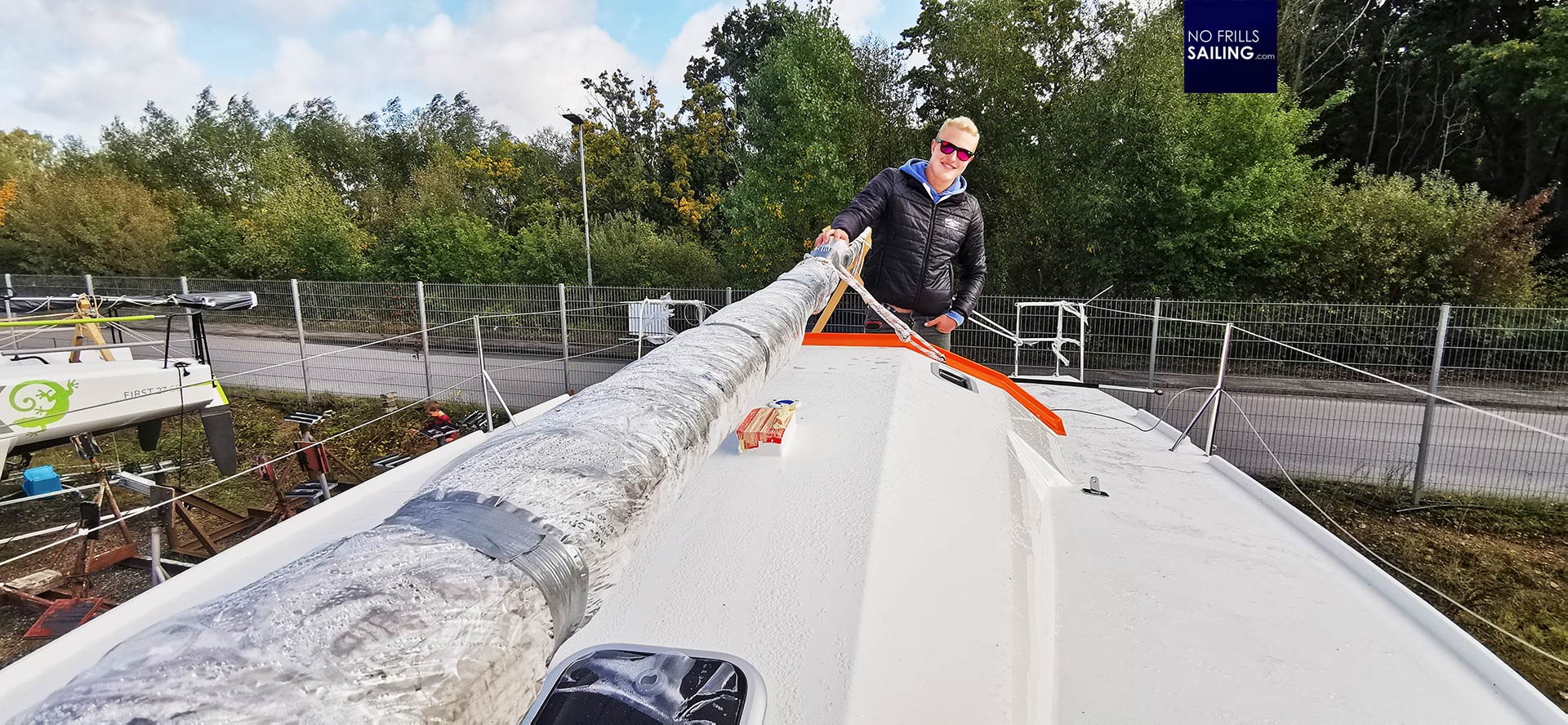
The hull including mast, standing and running rigging, is around 50.000 Euros ex VAT. This is a surprisingly low price, I wonder, since the boat is made with infusion technology and 3D core foam. High tech materials and production methods. Yet, Hendrik needs at least the same budget again to be spent on sails, deck gear and financing his Mini Transat campaign: “I work hard for coming up with all the money, but a sponsor taking on at least a part, naturally, would be great of course!”
Totally costumizeble
And such a future sponsor will get a pretty darn good skipper: Hendrik is a keen regatta sailor and – at least for the Baltic Sea, there is seldom a race he misses. “We will see”, he says and shoots out a winning smile: “There´s plenty of time. I am going to customize the boat to my needs over winter. For that, I´ve rented a shed where the boat will be transferred to.” Hendrik places himself on the port side at the helm.
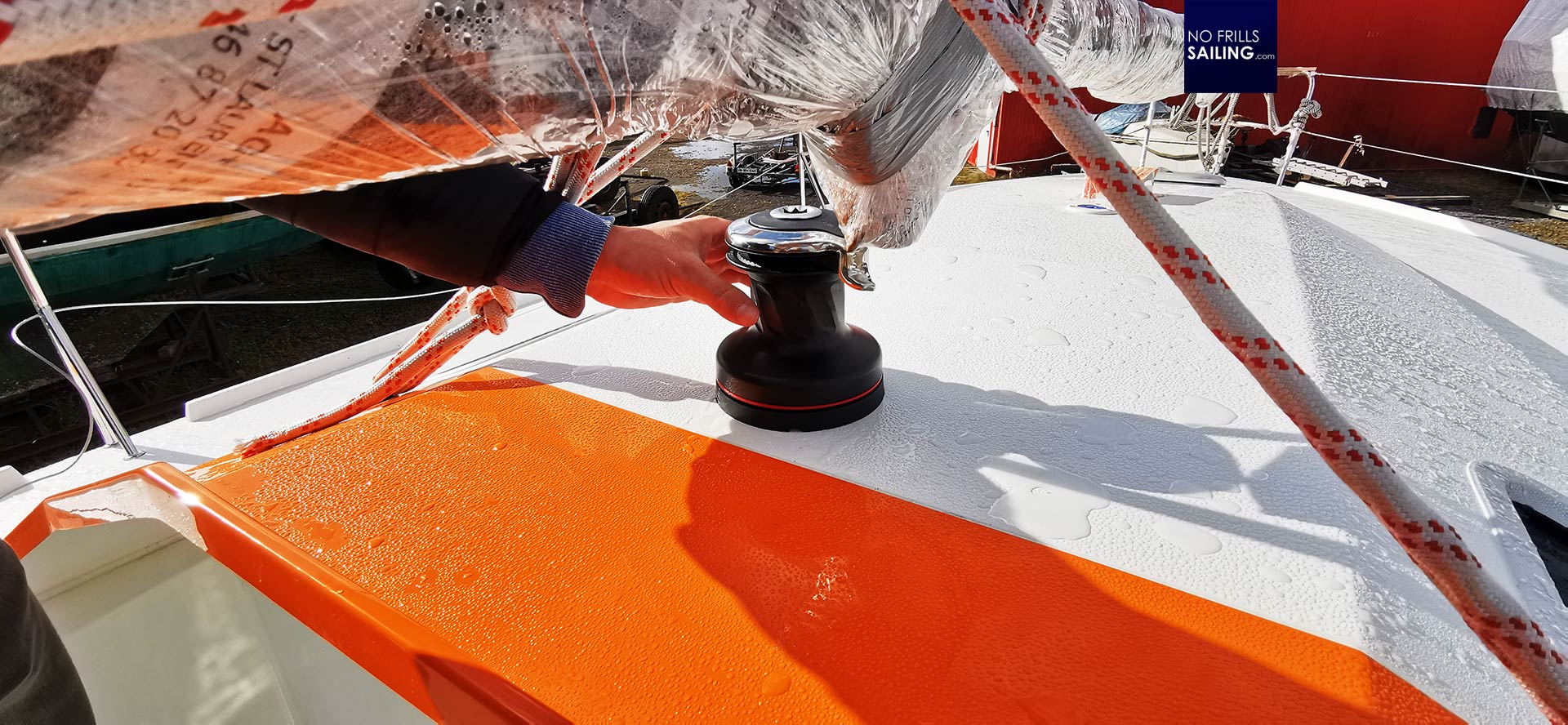
The Vector 6.5 can be bought ”naked”. Skilled boat builders and sailors like Hendrik can now decide where to put the winches, where to put the cleats and all gear. In this, the boat can be tailor-fit to the needs of the skipper´s very own body. Again, how much time can be saved by a winch that does not require to change seating position when working on the lever? A thousandth of a second? Yet, how many times over does a skipper have to fine trim the sails … multiplied by the thousands of miles in a Mini Transat race. A lot of gain.
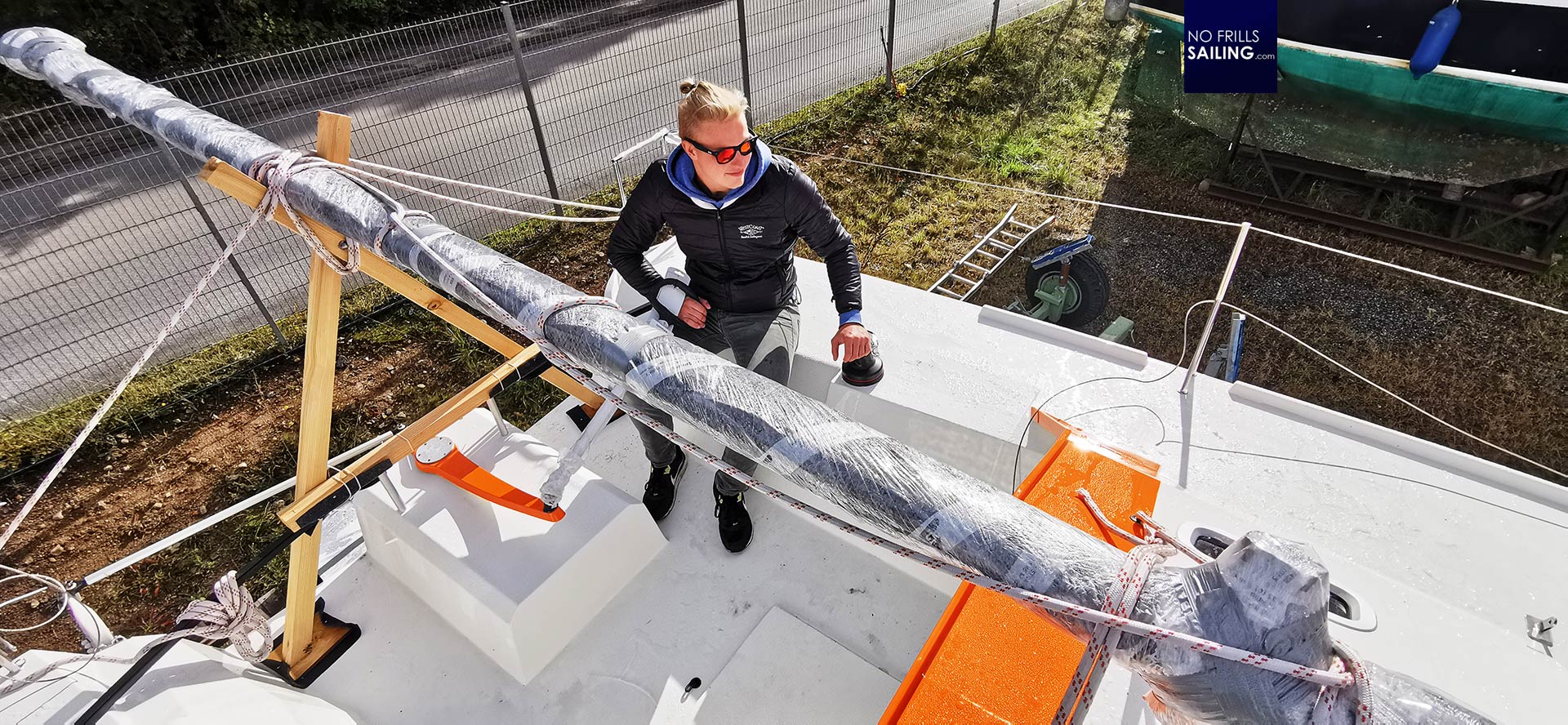
The boat will receive a central winch on the dodger and two Genoa-winches on the coaming. The mainsheet traveler has already been mounted by the yard, but according to the wishes of Hendrik. “On the old boat the traveler was positioned right in front of the entryway down, which was always a hustle having to go around the mainsheet when working the piano, now it´s much better.” Again, these subtle changes adding to the formula of winning a race or not.
Series boat versus prototype
“Still, a prototype would be even cooler”, he says. Why?, I ask: Just having a carbon made boat won´t make so much difference, or will it? “Well, just being admitted into the starting field with a series boat is a gamble. There are much more applicants than places. With a prototype, your starting place is almost safe”, Hendrik says. Secondly, he explains, the carbon-made Mini 6.5 is much light which directly translates into speed.
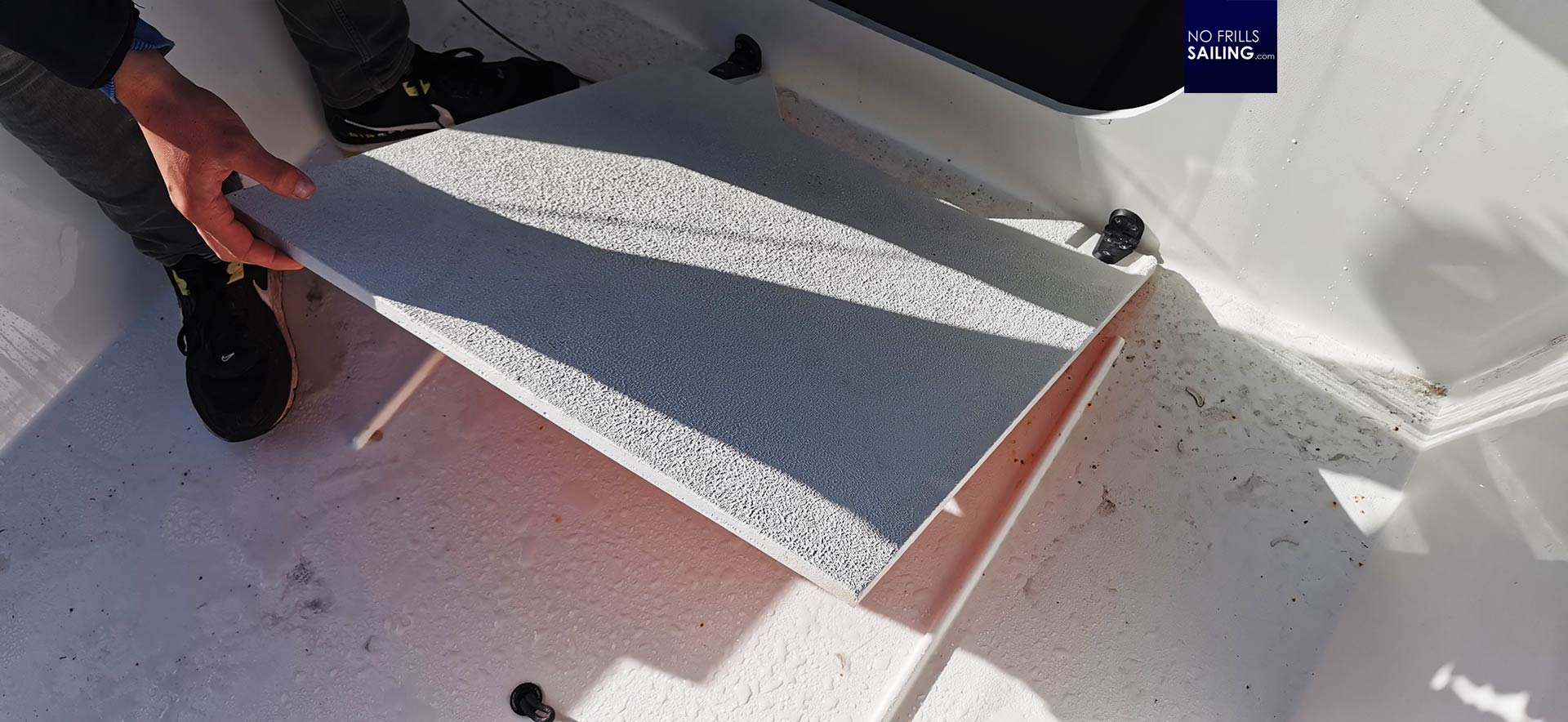
“Plus”, he says with a glow in his eyes, you can play around with many much, much cooler things: “Like you get a taller mast, ergo more sails area. Like the canting keel, which give you more power on the tougher points of sails. Or just take the whole topic of foils: This is something I would find absolutely amazing to have a foiling Mini!” He opens the entry to the boat´s interior and invites me to check it out.
Welcome to the inside
The Vector 6.5 comes with a slightly overhang dodger that also has a mini-wave breaker. “This is also new in regard to the former version. I hope that the amount of spray water in foul weather is at least reduced”, he smiles: I know very well by myself how nasty even the tiny Baltic Sea can get at times …
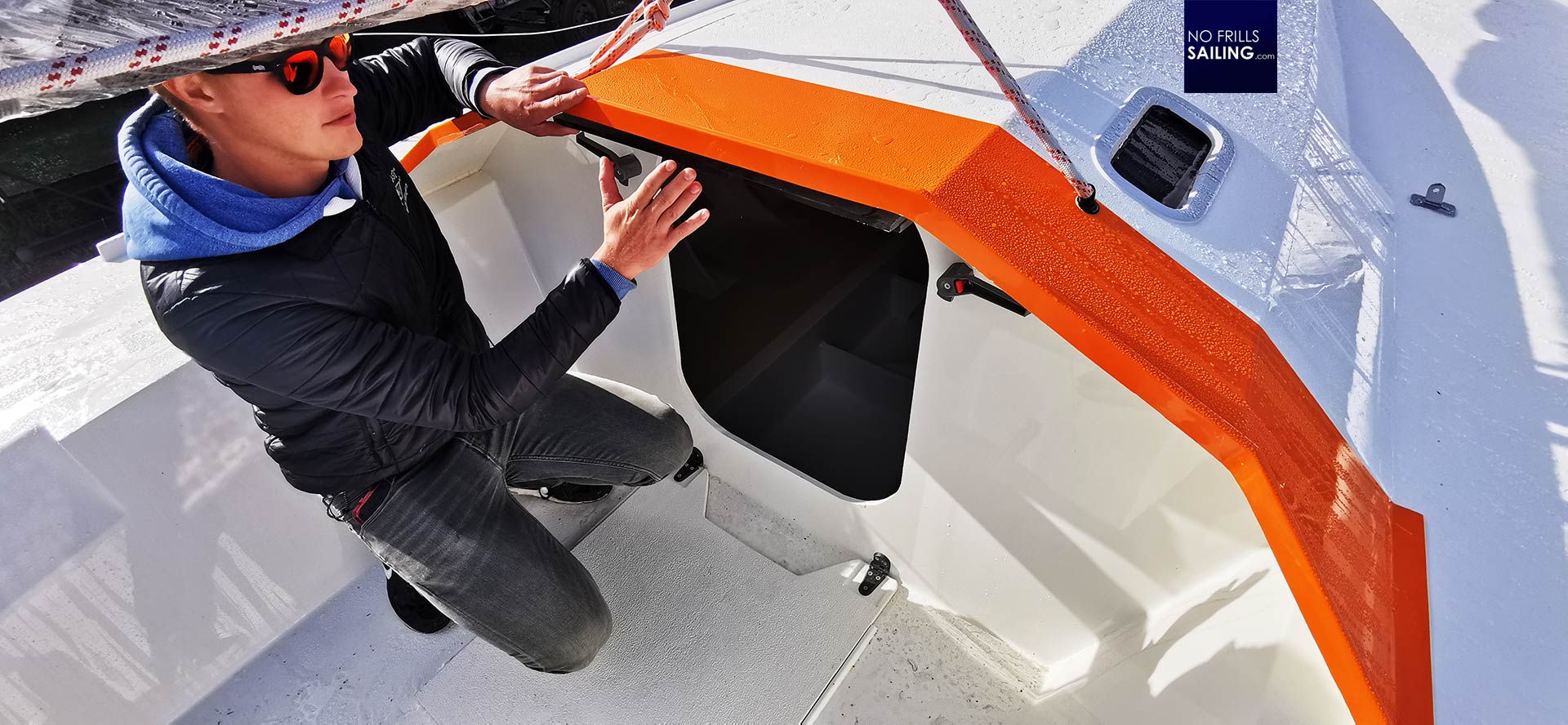
My first look into the inners of the Vector 6.5 is accompanied by a “Wooow!” The boat is just huge! And here I can clearly see what the huge deck area promised: The volume created inside is just amazing. The “saloon”, if one could call it this way, is even bigger than the counterpart on my old First 27 SE. The nice yellow-ish light that shines through the 3D-foam core creates a wonderful atmosphere. No need for any Top Coat-paint.
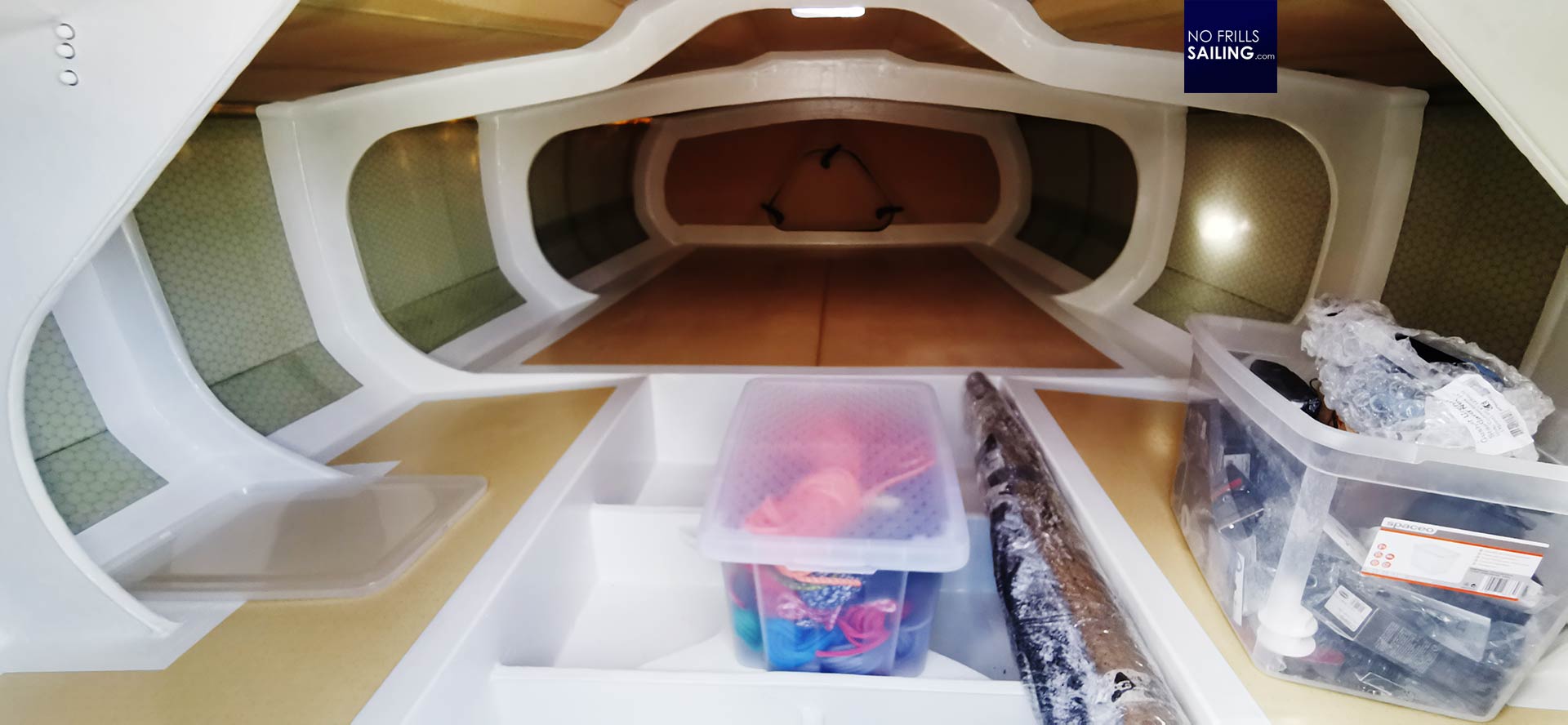
The Vector 6.5 has three watertight foam-filled chambers which, if the boat flips, gets struck by a reef or has a leak . “It shall swim safely on the water even when filled to the brim by the Ocean.”, he smiles. I love the forward compartment of the boat, directly in the bow: The scow-bow allows for huge volume underneath – I´d say any King-size bed in hotel rooms could hardly be offering more area.
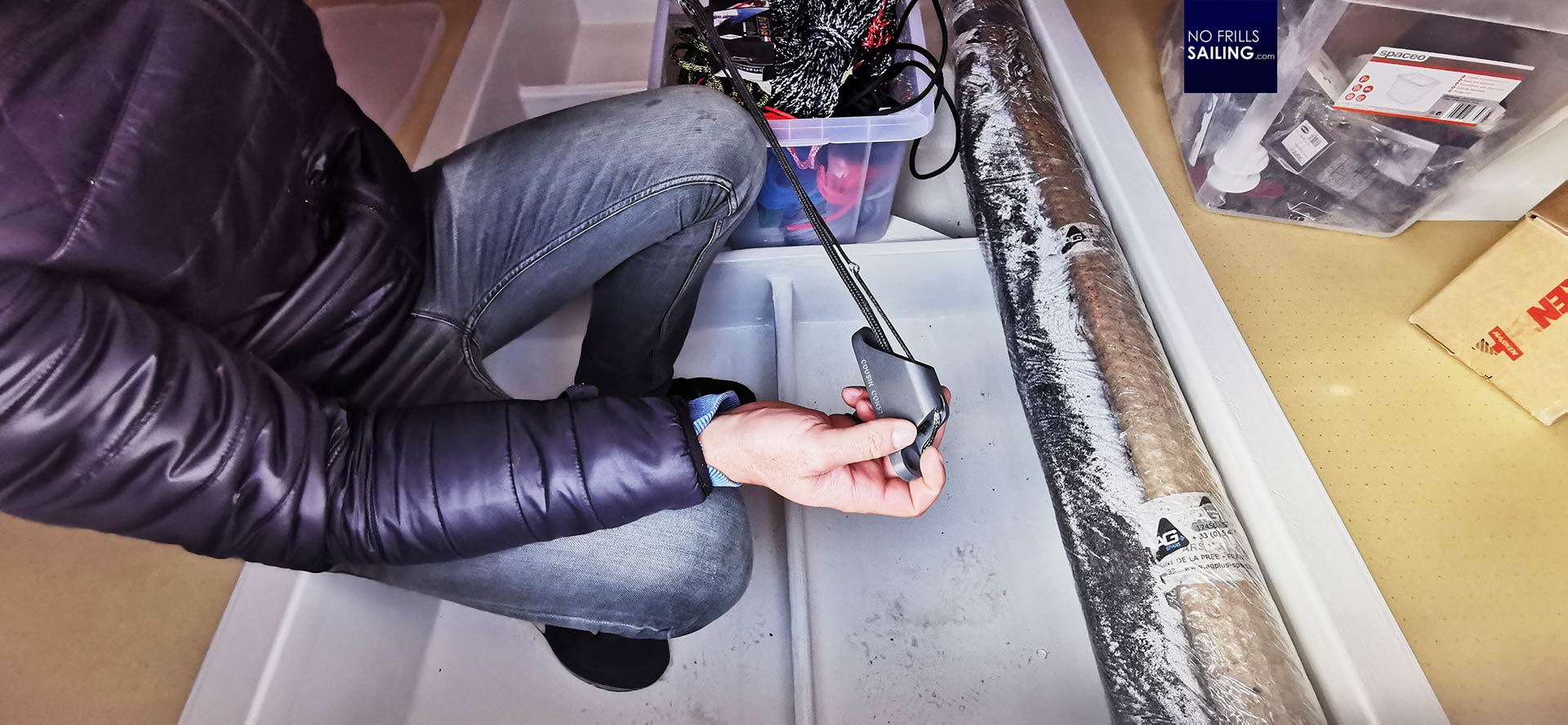
Hendrik shows some of the parts he bought: “I decided to get me some cool stuff, like those constrictor-clutches. They are not only cool looking but also much more kind to the material.” Hi plan is to relocate the boat in the coming weeks to start working over winter: Having her clear and ready to begin his regatta-season in 2023 on spot.
Hendrik´s fundraising campaign
“Still a long way to go”, say Hendrik who is well aware of the current situation: With a looming recession and news of crisis everywhere, inflation like a bad vortex beginning to pull more and more companies in, raising a budget to support his way to the Mini Transat gets even harder. “But I am confident that I can come up with a solution here.” He smiles. There´s no turning back, the boat is bought and for Hendrik it´s not if but how he will hoist his sails next year.
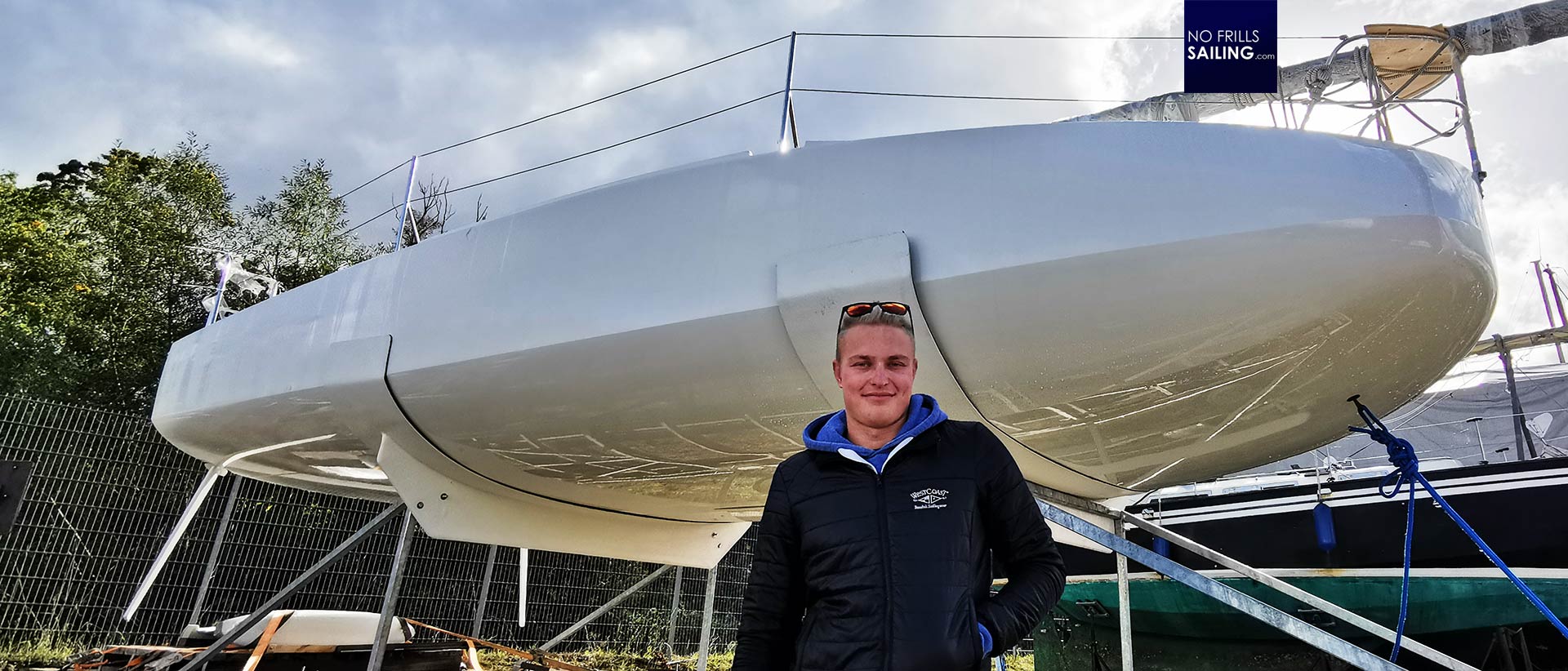
This cool young dedicated man! We say Goodbye and whilst we shake hands Hendrik promises me to take me with him in his brand new PLAYGIRL 2 when ready to sail next spring. Hoping that he will find a way to raise the budget needed to support his dreams of competing at Mini Transat, we part. I drive away and see him climbing onto his boat again in my driving mirror: Surely, he is going to work for an hour or two on his boat to fit some parts. How cool must it be to be young again, I think to myself, and being so close to make a dream come true !
Classe Mini 650: Here is some more fuel for you:
PLAYGIRL : Hendrik Decker´s fast Mini racer
Endgame Mini Transat: Lisa Berger sets full canvas to her dream
Lizzy Foreman on the Mini Transat race
- OC Wally Cento
- 84 Mini Maxi
- IMOCA Open 60
- Consultancy Services
- 30m Blue Water Cruiser
- 25m Explorer Yacht
- 24m Fast Cruising Catamaran
- 23m Performance Cruiser
- 20m Explorer Yacht
- 20m High Performance Cruiser
- 18m Blue Water Cruiser
- 15m Performance Cruiser
- 15m Explorer Yacht
- 12m Explorer Yacht
- Multihull Design
- 18m Explorer Yacht
- 40m Blue Water Cruiser
- 40m Cruiser Racer
- 33m Performance Cruiser
- 30m Wally Cento
- 24m ORCsy Racer Cruiser
- 24m Day Sailer
- Carbon Component Design
- Yacht Performance Development
- CFD and Model Testing
- Twin Rudder Steering Systems
- Custom Deck Hardware
- Modifications and Refit
- VPP Routing and Sail Analysis
- Classic Yacht Refit & Optimisation
- Naval Architecture
- Engineering
- Rudder Design
- Brokerage Services
- 'Seahorse Magazine' #192
- 'Divoc' #190
- Lucent #180
- Influence #171
- 'Eora' #169
- 'The Three Brothers' #168
- 'Edenred' #165
- 'BHB3' #163
- 'Teata' #148
- 'Kite' #144
- ‘Sensei’ #131
- 'Gryphon' #106
- 'Horizon' #104
- 'Sabre II' #93
- 'Letto Di Pletto' #47
- 'Mowgli' #41
- 'Graybeard' #39
- 23.8m Ultime Trimaran
- 20.7m Orma Trimaran
- 18.28m Orma Trimaran
- 16.75m Cruising Catamaran
- 16.1m Cruising Catamaran
- 12.8m Crowther Shockwave Catamaran
- 9.1m Seacart 30 Trimaran
- 26.3m Aluminium Sloop
- 21.0m Steel Schooner
- 21.0m Aluminium Cruising Ketch
- 20.0m Aluminium Explorer Yacht
- 20.0m Luca Brenta Racer Cruiser
- 19.6m Aluminium Bluewater Cruiser
- 19.2m Aluminium Lifting Keel Sloop
- 18.8m Custom Steel Sloop
- 18.23m Mylius Racer Cruiser
- 16.0m Sly Cruiser Racer
- 14.5m Aluminium Cruising yacht
- 13.87m Wooden Motor Sailer
- 11.6m Classic Pilot Cutter
- 25.25m Reichel Pugh Maxi
- 18.28m IMOCA 60 Nexans WeWise
- 18.28m IMOCA 60 'Canada Ocean Racing'
- 18.28m IMOCA 60 One Planet
- 15.85m TP52 Georgia
- 15.84m TP52 Racing Yacht 'Alizee'
- 15.25m Pegasus Open 50
- 12.8m Fast 40
- 10.89m Figaro 3
- 10.11m Sun Fast 3300
- 19.2m Lifting Keel Sloop
- 14.5m Aluminium Cruising Yacht
| in the Route du Rhum and 1st in the Lodi Group Trophy (40' Malouine). Her sister ship won the 2023 Fastnet Race. She has been prepared and optimised in all aspects with two full-time marine professionals since her launch. LOA: 12.19 m For further details, access to the image library or arrange a viewing contact: |

Log in or Sign up
You are using an out of date browser. It may not display this or other websites correctly. You should upgrade or use an alternative browser .
(Scow bow) - vs - (Wave piercing bow)
Discussion in ' Boat Design ' started by Gunnar Sommerlund , Jul 10, 2017 .
Gunnar Sommerlund Marine Engineer
Hello, this is my first time on this forum "i have been lurking around". <- (Bear with me) I haven't been able to find information regarding " differences " between scow and piercing bow types. I know that a sharp bow has a minimal wet surface, while scow i focused more about planning capabilities and is popular in lake sailing (in America). The reason i,m asking is because i have decided to spend next couple of years designing a sailboat in range of 25' to 30' foot. for sailing inshore waters of Denmark, and participating in local races now and then. The Scow seems to be gaining popularity (in mini transat) and i cant stop wondering why there arent more of them around. I have uploaded an example of arkemas mini transat and figaro 3 . I Absolutely love their designs. They are both made for open ocean right?
Doug Lord Flight Ready
The scow shape for Mini's began with David Raisons boat a few years ago and has proven to be very fast. The newest versions like Arkema and SeAir have taken another major leap in technology utilizing lifting foils to completely fly the boat. And two years ago Hugh Welbourn and Quant boats introduced the worlds first foiling keelboat scow the Quant 23.Very exciting times! The Quant 23 takes off in a 5 knot breeze and foils upwind in 7-8knots of wind. It uses a unique foil system that doesn't require constant adjustment and that drastically increases the righting moment of the boat. According to those that have sailed it ,it is very easy to learn to fly: SeAir Mini with Welbourn foil system:
Doug Lord said: ↑ The scow shape for Mini's began with David Raisons boat a few years ago and has proven to be very fast. The newest versions like Arkema and SeAir have taken another major leap in technology utilizing lifting foils to completely fly the boat. And two years ago Hugh Welbourn and Quant boats introduced the worlds first foiling keelboat scow the Quant 23.Very exciting times! The Quant 23 takes off in a 5 knot breeze and foils upwind in 7-8knots of wind. It uses a unique foil system that doesn't require constant adjustment and that drastically increases the righting moment of the boat. According to those that have sailed it ,it is very easy to learn to fly: View attachment 134445 SeAir Mini with Welbourn foil system: View attachment 134446 Click to expand...
Gunnar, I haven't sailed a Mini but while I think the new scows are amazing I think they are not pretty in the traditional sense. I guess it depends on what you want to do. I would consider using foil assist if not full flying. Good Luck!
gonzo Senior Member
The Mini Transat has developed boats specialized in downwind sailing. If that is what you are considering, the blunt bow and shape conducive to surfing is great. For an all around boat, it is not the best.
SamSam Senior Member
Here's an article in a "Yazi" magazine about bow types. On page 3 they discuss (a little bit) about the 2 types you're interested in. How to make a better yacht bow http://www.boatinternational.com/yachts/yacht-design/how-to-make-a-better-yacht-bow--799 You might try 'searching' in the various forums here. Also, usually at the bottom of the page of whatever you are looking at is a list of 'similar threads' which is an automatic search feature. Welcome.
gonzo said: ↑ The Mini Transat has developed boats specialized in downwind sailing. If that is what you are considering, the blunt bow and shape conducive to surfing is great. For an all around boat, it is not the best. Click to expand...
Search Results for Query: piercing bows | Boat Design Net https://www.boatdesign.net/content-search/92268/?q=piercing+bows&t=post&o=date Search Results for Query: scow bows | Boat Design Net https://www.boatdesign.net/content-search/92270/?q=scow+bows&t=post&o=date
Gunnar Sommerlund said: ↑ That is good to know. Becouse i,m looking for a design that preforms well inshore. Coastal cruising no more then 20 miles from shore. Click to expand...
Thank you guys for the links. I will lurk arround and post what crazy ideas i come up with =)
CT249 Senior Member
One issue is that one of the big benefits of the scow is that they increase righting moment, but often at the expense of extra wetted surface and wave drag as I understand it. The extra righting moment is more of a plus if you have a big rig, and the extra drag is less of a problem if you have a big rig and a significant problem if you have a small one. So you tend to see scow bows on boats with big rigs. In some ways, something like a 25 foot scow is often simply a 28 foot boat with the bow chopped off; in fact in some small boat classes where there was a length restriction and big rigs, designers just used to design a longer boat and then effectively chop the bow off at the desired length. So you had 14 foot "snub bow" boats that were effectively 16 footers with the front cut off. It may just underline how designing a boat to a set overall length is actually quite artificial in some ways. A 22' scow would often become a better boat for minimal extra cost if you added with 3' of pointy nose onto it. Which leaves one to wonder where the advantage is, if one is not limited by LOA.
Scows, like the inland lake scows in the US and even the Mini scows are designed to sail at an angle of heel that reduces wetted surface and changes how the bow interacts with waves. You can see how much the wetted surface is reduced with the right angle of heel in the pictures below:
PAR Yacht Designer/Builder
The advantage of a scow hull form is the heeled waterline symmetricity, compaired to a more conventional canoe body. A a scow heels and as Doug points out, the typical canoe body's WL's tend to become very asymmetric with a strong rounding moment, yet the scow's WL's are less so and move dramatically to leeward, increasing the couple, but also decreasing resistance. Comparing a fine bow canoe body, particularly if fat butted for downwind efforts, to a scow just isn't a fair comparison. They're using different principles and hydrodynamic tricks to get their performance envelop. For inshore cruising and occasional racing, the more common triangular canoe body would be the reasonable choice. The scow is a fairly specialized hull form and you'll get dinged pretty hard, if you show up at the local 'round the buoys event, with a scow against a bunch of canoe sloops. Lastly, the scow hull form isn't the best choice for a cruiser, IMO, just no internal volume, which is high on the priority list in a cruiser.
Paul, when you compare a "Mini" scow hull with another 21-22 footer the Mini has a ton of internal volume but the 28' E scow sure doesn't-like you said.
- Advertisement:
PAR said: ↑ The advantage of a scow hull form is the heeled waterline symmetricity, compaired to a more conventional canoe body. A a scow heels and as Dog points out, the typical canoe body's WL's tend to become very asymmetric with a strong rounding moment, yet the scow's WL's are less so and move dramatically to leeward, increasing the couple, but also decreasing resistance. Comparing a fine bow canoe body, particularly if fat butted for downwind efforts, to a scow just isn't a fair comparison. They're using different principles and hydrodynamic tricks to get their performance envelop. For inshore cruising and occasional racing the more common triangular canoe body would be the reasonable choice. The scow is a fairly specialized hull form and you'll get dinged pretty hard, if you show up at the local 'round the buoys event, with a scow against a bunch of canoe sloops. Lastly, the scow hull form isn't the best choice for a cruise, IMO, just no internal volume, which is high on the priority list in a cruiser. Click to expand...
- No, create an account now.
- Yes, my password is:
- Forgot your password?


Published on October 11th, 2022 | by Editor
Scow bows rule the seas
Published on October 11th, 2022 by Editor -->
Class organizations such as the Mini 6.50, Class40, and IMOCA support offshore competition, and when courses are long enough, routing seeks out the benefits of offwind angles. Over time, designing to these class rules have developed hulls that may not go upwind too well but more than make up for it as the wind angles comes back.
Such as the scow bow.
Sam Manuard is a renowned architect in the scow world, and what began as a radical concept with the Mini Class, has seen its success trickle up to the Class40 and IMOCA which will be on full display in the 2022 Route du Rhum when it starts November 6.
These big bowed boats will be spanning the transatlantic from France to Guadeloupe, with the 3543nm course providing the latest test. Here are some comments from Manuard in boatsnews.com :

Regarding the state of design: Nowadays, everyone makes scows. There is no more debate on the subject. There are always nuances on the scow theme. Lombard with the Lift has made a very powerful boat, VPLP with the Clak40 which looks more versatile. It’s progressing well and the different designs are pretty close in performance. Everyone has raised their game.
Versatility versus all-around performance: We are interested in the statistical distribution of wind and speed for this type of race. We also look at races like the Fastnet, the Normandy Channel Race to have a boat that is efficient in light airs, that goes upwind well. Having a flat spectrum is quite interesting. In the design loop, the Mach5 (his latest design) has the Route du Rhum as its primary objective. But also the other races, not necessarily with the same level of priority. In any case, the choices made should be effective on all types of races.
But for an offwind race like the Route du Rhum… With an increasing number of scows, the classic (non-scow) boats no longer have a chance of winning.

Tags: boatsnews.com , Class40 , Route du Rhum , Sam Manuard
Related Posts
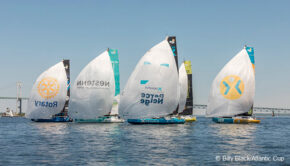
Leg 2 complete for Atlantic Cup →
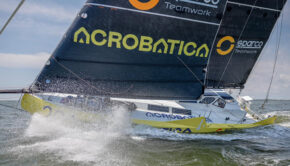
Leg 1 complete for Atlantic Cup →
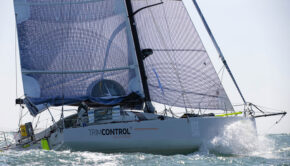
Countdown to 2024 Atlantic Cup →
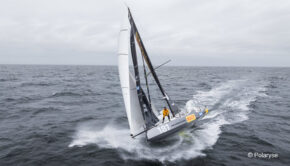
Italy wins Transat CIC Class 40 title →
© 2024 Scuttlebutt Sailing News. Inbox Communications, Inc. All Rights Reserved. made by VSSL Agency .
- Privacy Statement
- Advertise With Us
Get Your Sailing News Fix!
Your download by email.
- Your Name...
- Your Email... *
- Email This field is for validation purposes and should be left unchanged.


- News & Views
- Boats & Gear
- Lunacy Report
- Techniques & Tactics
CRUISER-RACER CONFUSION: Scow Bow Revolution 29 and Gunboat G4 Capsize
This is something I ask myself quite often: can a modern truly cutting-edge high-performance racing sailboat also be a cruising boat? In certain ways, of course, the old ideal of the true cruiser-racer, per the glory days of the Cruising Club of America rating rule and boats such as Carleton Mitchell’s famous yawl Finisterre , evaporated many decades ago. Yet still it is an ideal that both boatbuilders and boat owners incessantly aspire to somehow realize in a modern context, and it is fascinating to watch how these aspirations manifest themselves. Take, for example, the Revolution 29 (see image up top), a new cruising design developed in France that is directly based on David Raison’s radical scow-bowed Mini 6.5 in which he won the Mini Transat in 2011.
Raison’s Mini was not just radical in appearance; it was radically fast and won the 2011 Transat by a large delta, setting a new course record in the process. This success was so significant that other important monohull racing classes—Open 60s, Class 40s, TP 52s—pretty quickly banned scow bows for fear their existing fleets would instantly be rendered obsolete. Development of the concept continues however within the Mini class, which has long been a leading hotbed of high-performance monohull sailing innovation.
David Raison arrives in Brazil aboard TeamWork Evolution in 2011 after crushing the rest of the Mini fleet
What’s interesting about the scow bow, of course, is that it is one of those few racing innovations that immediately and obviously has critical advantages in the cruising market. As in: if you make the bow of any boat much wider you have lots more space inside for accommodations.
Interior of the Revolution 29. A whole lot of space for a boat this small. Note there is also a predecessor design, the Revolution 22, more directly based on the 22-foot racing Mini
But putting a scow bow on a cruising boat obviously doesn’t instantly make it a “cruiser-racer.” What makes the scow bow super-competitive is that it facilitates a boat’s ability to plane, and the other key factor in that equation is always weight. Or rather the lack of it. Load up a boat with lots of furniture and gear and you will seriously inhibit its ability to plane regardless of what shape its bow is. As always, a certain balance must be achieved and compromises must be made.
To get an idea of what a competitive scow-bow boat looks like under sail, watch this viddy here of TeamWork Evolution drag-racing against a conventional Mini.
You should note in particular the boat’s insanely huge sail plan. Prototype Minis are renowned for these, and obviously the rig on any reasonable cruising boat would want to be quite a bit smaller. One question in my mind is whether you in fact need all the extra sail area to make the scow bow fast. Could it be that with more cruiser-sized sails the scow bow might actually be slower than a conventional bow?
The new G4 does its flying thing
Another question being openly discussed right now, thanks to Gunboat and its new G4 foiling catamaran , is whether foils make any sense on a “cruiser-racer.” As I mentioned in my previous post on the boat, it is the first fully foiling boat with any sort of accommodations, and Gunboat has been marketing it as a coastal cruiser-racer. And now in its racing debut at St. Bart’s the svelte little beast has capsized in dramatic fashion, which has prompted some forum trolls as well as a few otherwise polite people to wonder out loud how this could possibly be termed a cruising boat.
Wipe Out from Gunboat on Vimeo .
Watch the viddy here first and then ask yourself: did the boat capsize because it was foiling, or did it capsize because the crew was unable to release the mainsheet for some reason? To me it definitely looks like the latter and that this would have happened, given the issue with the sheet, to any performance cat whether it was airborne or not.
Actually in this image it looks like that helicopter might have been a precipitating cause
Gunboat CEO Peter Johnstone, post flip
So maybe we shouldn’t be focussing on the foils so much. After all, as I understand it the G4 was originally developed as a straight performance cat and the flying foils were added later in the process. Like the AC72s in the last America’s Cup go-round, the G4 wasn’t born a foiler, but evolved into one. Also, of course, it is perfectly obvious that the boat capsized because it was being raced and not cruised. The crew was pushing the boat to its limits, and just because it has a limit (like any boat) doesn’t mean it can’t be cruised. For example, I have a friend who once owned a heavy full-keeled Tayana 37 that was dismasted during a distance race because he declined to take his spinnaker down when conditions got strong. The spinnaker in a gust just pulled the mast right off the boat. Which obviously doesn’t mean you can’t go cruising in a Tayana 37.
I think the real question to ask is: is there a point at which a boat becomes too performance-oriented to really be termed a cruiser? Which really is just another way of asking: what exactly is a cruiser-racer?
Back in the days of Carleton Mitchell and the very conservative CCA rule it was a pretty simple concept. A cruiser-racer was a boat designed to cruise that you could also race, and basically all you had to do to do that was take a ton of crap off the boat and—if you were very serious—bend on different sails. Back in those salad days, that was all it took to be competitive at the highest levels of racing.
These days there are many more variations of the species. There is a vast universe of older boats racing mostly under the PHRF rule in local beer-can series that are very obviously cruising boats that are being raced just for fun. We have a few what I call “captive venues,” the best example being Swans, where there is a small universe of very active racing focussed usually around a brand, where an honest-to-God cruising boat can engage in some pretty serious racing with other cruising boats. We have fancy expensive “performance cruisers” with luxurious interiors that can be raced if desired with minimal changes to the boat (this is pretty much the category the larger Gunboat cats fall into). We have a few even more insanely expensive performance cruisers with wholly interchangeable interiors for both cruising and racing. (I have even seen boats with interchangeable keels!) We have various folding trimarans with cramped accommodations that can be raced in various events. We have families with small children cruising around the world in modified open-class ocean racers. We have “buckets” where enormous super-yachts, obviously designed for cruising in the most obscenely opulent sense of the term, can race against each other.
And on and on and on. The market for sailboats that can be both raced and cruised has become so complex and variegated it is impossible to say where it begins and ends.
Really the only advice I can give to help make sense of this spectrum is that the terms “cruiser-racer” and “racer-cruiser” should not be used interchangeably. Rather we should agree on two specific definitions. As in a cruiser-racer is a boat designed to cruise that can also be raced, and a racer-cruiser is a boat designed to race that can also be cruised.
The G4 I think is certainly a racer-cruiser, and perhaps to some it is an extreme example, but I for one would be very happy taking it out for a week’s worth of high-octane gunkholing.
IN OTHER DEVELOPMENTS: There’s some buzz on the Sailing Anarchy forums that the Gunboat 55 Rainmaker , abandoned after being dismasted back in January , has been spotted again, afloat, but with her coachroof torn away (remember, this is an open-bridgedeck boat, the roof is merely shelter). There’s even one guy claiming the boat has been towed in somewhere, but so far there’s no confirmation of this. I have heard confirmation of the boat’s being spotted, and of the damaged coachroof, from the boat’s designer Nigel Irens via third parties.
Related Posts

- SAILGP 2024 NEW YORK: Lifestyles of the Rich and Famous

CRAZY CUSTOM CRUISING BOATS: New Rides for Pete Goss and Barry Spanier
The scow bow helps the boat surf, especially sailing off the wind. But how is it beating into steep seas?
@Damon: That is the question, for sure. Even if it’s still fast to windward, I bet it’s not exactly comfortable. One advantage of the shape is the waterline area is likely very symmetrical when the boat is heeled, but I guess the bow must pound something fierce.
I think the answer to your question is, yes.
This type of fast – cruising, would be different than what cruising has evolved into since the Finessterre days.
Today, cruising can mean a life choice/commitment of living for decades on a sailboat. The cruising sailboat that must serve as a home at sea has evolved into a complicated and commodious(and expensive), vessel.
To cruise in a high performance boats like you’ve posted, means going light. Backpacking as compared to RV-ing. The speed could be a whole new adventure and lure for younger sailors. But it will come at a cost of comfort and maybe will become less of a time commitment, as back packing is(not many backpack open-ended, for decades).
It appears less people today are jumping into the life choice cruising mantra of the 60’s and 70’s. Yet sailing is as popular as ever with young and old(around me).
I see this notion of a lighter, smaller, faster(cheaper), sailboat on a ‘sail’, as having appeal to a new generation of sailors my kids(and their friends) age, as they grow into a life(and the means), that includes sailing.
Speed is good and will take skill to tame(I love 4kts)!
I have cruised and raced my light, go fast boat for 25 years, loved every minute.
I am drawing a 42′ idea, 14′ beam, looking at 10-12 as a good speed for us elders (me 69, she 66). assy lee boards, unstayed rig, two winches, lots of hatches and deck openings. I built an Atkin Ingrid in 1969-74 and sailed her from San Fran to NZ. As a sailmaker who raced 5O5 at WC level for awhile, the slowness and poor performance upwind of that double ender shape was always tough to trade for some speed. not to mention low and wet. When i hitched a ride from Tahiti to Maui on a Cal 39 it really showed me how nice the speed could be for comfort as well. Better wave synch etc.
thirty years of windsurfing speed and early foiling tri’ experience (Longshot) leave a deep impression about how fast we can go… but 10-12 will do for this stage of my ocean travel dreams. plus, samantha isn’t comfortable with the whole concept yet. got to make it comfy. our Westsail 42 is growing on her, and she’s getting used to that scale of living aboard .
thus, i’d love to hear from anyone who has had some experience with these shapes in head seas. i’m right there with the french concept. so happy to let them find out these things before my paper becomes a boat.
bob johnstone sailed the grot baer across oceans. he probably wasn’t in a hurry. but he must have been comfy enough. if you are truly voyaging, and not sight seeing on a plan, you rarely need to go to weather. it’s a choice. you just have to be flexible about destination and time, no schedules. with today’s weather magic on the net there is even more choice of routing underway for comfort… as long as you are more about the voyage than the destination. obviously i approve of aimless wandering… and have a wife who loves the easy sailing, hates the other bit, and is willing to just be out there,
if that is what it takes to bring her on board happily, i’m on with it. it’s all a bunch of compromises, for senior citizens like us to be voyaging viable for another bunch of years, then end up in freemantle or perth with a nice liveaboard until you can’t get up/down/in/out, that suits us.
i expect our vessel will sail very well. a good compromise.
and that pounding thing. i see mushy pushing, throwing the spray off. the slab side forward when heeled? might that pound? i busted the bow bulkheads out of a ranger 37 pounding to weather. once. maybe mushing is better.
i really am imagining all of it more and more. hope to feel the water doing whatever it wants ASAP.
I was watching the wave action and the helmsman action. He did the right thing to release the main but it was not enough. Secondly the person responsible for the genoa sheet was pulling in when he should release. It does appear that the chopper is the culprit to give them dirty air washed down from the blades. Lastly why is it that not a single one was wearing lifejacket in this kind of boat. It is a different class of sailing and may not appeal to some mundane sailors but is it such fun to the adventurous types. Keep it up!
I think anyone who’s ever noticed the sink and wood trimmed mirror down below in a J 24 knows the Johnstone’s tendency to put accomodations into boats which aren’t really safe to cruise in.
Leave a Reply Cancel Reply
Save my name, email, and website in this browser for the next time I comment.
Please enable the javascript to submit this form

Recent Posts
- MAINTENANCE & SUCH: July 4 Maine Coast Mini-Cruz
- MAPTATTOO NAV TABLET: Heavy-Duty All-Weather Cockpit Plotter
- DEAD GUY: Bill Butler
- NORTHBOUND LUNACY 2024: The Return of Capt. Cripple—Solo from the Virgins All the Way Home
Recent Comments
- Brian on THE BOY WHO FELL TO SHORE: Thomas Tangvald and Melody (More Extra Pix!)
- cpt jon on NORTHBOUND LUNACY 2023: Phase Two, in Which I Exit North Carolina via Oregon Inlet
- Sanouch on A PRINCE IN HIS REALM: The Amazing Life of Thomas Thor Tangvald
- Peter Willis on DEAD GUY: Donald M. Street, Jr.
- January 2024
- December 2023
- November 2023
- October 2023
- September 2023
- August 2023
- February 2023
- January 2023
- December 2022
- November 2022
- September 2022
- August 2022
- February 2022
- January 2022
- December 2021
- November 2021
- October 2021
- September 2021
- February 2021
- January 2021
- December 2020
- November 2020
- October 2020
- September 2020
- August 2020
- February 2020
- January 2020
- December 2019
- November 2019
- October 2019
- September 2019
- August 2019
- January 2019
- December 2018
- November 2018
- October 2018
- September 2018
- August 2018
- February 2018
- January 2018
- December 2017
- November 2017
- October 2017
- September 2017
- August 2017
- February 2017
- January 2017
- December 2016
- November 2016
- October 2016
- September 2016
- August 2016
- February 2016
- January 2016
- December 2015
- November 2015
- October 2015
- September 2015
- August 2015
- February 2015
- January 2015
- December 2014
- November 2014
- October 2014
- September 2014
- August 2014
- February 2014
- January 2014
- December 2013
- November 2013
- October 2013
- September 2013
- August 2013
- February 2013
- January 2013
- December 2012
- November 2012
- October 2012
- September 2012
- August 2012
- February 2012
- January 2012
- December 2011
- November 2011
- October 2011
- September 2011
- August 2011
- February 2011
- January 2011
- December 2010
- November 2010
- October 2010
- September 2010
- August 2010
- February 2010
- January 2010
- December 2009
- October 2009
- Boats & Gear
- News & Views
- Techniques & Tactics
- The Lunacy Report
- Uncategorized
- Unsorted comments
Yachting World
- Digital Edition

Ugly – but fast?
- Elaine Bunting
- April 16, 2012
The latest hot trend in ocean racing design is the scow bow. But it's ugly and it looks as if it'd be brutal upwind

I’m torn when I think about the latest trend for ocean racing, the scow bow. On the one hand, it’s a fascinating development. On the other…cripes, these new designs are ugly.
Round bowed scows have been well proven; the skimming dish designs have long been popular in the US, though less so in Europe. Yet the design principle made no major inroads into offshore design until last year, when French engineer and solo sailor David Raison won the Mini Transat in his self-designed mini 6.5m Mini Magnum/Teamwork Evolution.
This round bowed, push-me-pull-you 21-footer beat the 2nd placed prototype Mini to the finish in Brazil by 130 miles – a huge margin in such an evenly matched fleet – and recorded an average across the entire Atlantic of 6.8 knots.
He nicknamed his wide-bodied design ‘le gros porteur’, the jumbo jet, in reference to its max beam, carried as far forward as possible.
Now there is a proposal from design group Reichel/Pugh for a 90ft scow (pictured above) designed to attempt to beat the Transpac record. We’ve got a full report on this intriguing design in our May issue.
The basic principle of the scow design is to maximise hull righting moment. The beam is carried well forward which means that, when heeled, the hull lines are further outboard than with a conventional bow. This makes the scow design very powerful when reaching, obviously important on races such as the Mini Transat or the Transpac, which have a predominance of reaching conditions.
It has the added advanced advantage of large reserve buoyancy in the bow to prevent the bow from burying or nosediving when driven hard off the wind.
Put that together with a canting keel, as is the case on David Raison’s boat, and you have a potentially very powerful yacht indeed.
However there are two snags with this design.
The first is that, upwind, the rounded bow slams, even when well heeled. This means it may not be that versatile a design or particularly comfortable in all-round conditions.
And in view of what are seeing in the Volvo Ocean race, which has suffered multiple structural problems in the harsh seas of the Southern Ocean, it would be a very brave designer (and sponsor) indeed that plumped for a scow design round the world or more general racing conditions.
Secondly, let’s face it: these two new extreme scow designs are not pretty. Would you want a yacht that looked like this? I wouldn’t. If your boat was jarring as this, you’d have to win.
But since Raison’s dramatic victory, I suspect designers everywhere have been playing around with the scow idea. In classes whose rules don’t place a restriction on maximum righting moment, it’s an obvious idea to explore. If it takes off, clever minds may even find some creative ways of softening the brutal front end.

IMAGES
COMMENTS
SailScow 37. Much of the drive towards scow bow cruising yachts is driven by top level racing sailors. Armel Tripon, who raced the then radical Sam Manuard-designed IMOCA 60 L'Occitane de ...
The Ace 30 is a new design intended to bring the scow bow concept, popular among offshore racing machines, to IRC yachts. TAGS: Extraordinary boats monohull Top stories. Scow bow designs are still ...
This mini-cruiser may look quirky, even extraordinary, but wait till you see the space it provides below decks. Toby Hodges steps aboard from the Revolution ...
The short answer is more righting moment, both across the boat and longitudinally. For a given overall beam and keel weight, a scow bow gives more volume away from the centreline as well as more volume ahead of the centre of gravity. Instead of only having outboard volume from the middle of the boat to the transom as on a pointy boat, with a ...
3rd AFEP scow signed Raison . Launched with the Revolution 22 in 2012, the range of scow-bowed sailboats from the AFEP shipyard in La Rochelle continues to expand. Still backed by architect David Raison, renowned for his Mini 6.50s, the builder then developed the Revolution 29, and in 2021 will present the third, intermediate model, the Revolution 24, a 7.25-meter-long, 2.89-meter-wide yacht.
Much of the drive towards scow bow cruising yachts is driven by top level racing sailors. Armel Tripon, who raced the then radical Sam Manuard-designed IMOCA 60 L'Occitane en Provence in the ...
Owen Clarke are the designers of this new Open Class 40 with a scow bow design currently in build at Evolution Marine. This, their sixth generation Class 40 des . Custom Yachts ... #15 Bolands Mill. Revolutionary design put that first boat on the podium in the 2006 Route du Rhum, the year where the emerging Class40 ended up dominating the entry ...
The modern hybrid-scow hull form provides many of the downwind advantages of the scow bow style craft, without sacrificing the boats performance to windward in waves." In essence, what that last section really refers to is based on the chines aft and a drag releasing hull form, so that the effort does not go to far forward into the full scow bow.
Scow bow trending for IMOCA 60s. Published on July 8th, 2022. Having started four Vendée Globes and finished two of them, once on the podium in third place, once after starting a second time nine ...
The Scow-bowed Mini racer. The Vector 6.5 is the latest generation series production Classe Mini 6.50 racer. The boat has been designed by Frenchman Etienne Bertrand in 2017, entering that year´s edition of the Mini Transat race as a prototype, finishing off at an impressive second place. The boat displays latest downwind running optimized ...
Scow bows. A relatively new trend for larger craft is the scow bow. It has been a fixture on Great Lakes A and C class sailing scows for many years, but its potential was suddenly realised when a Mini-Transat boat with a scow bow handily won the race. Now, designers Reichel-Pugh have designed a 27.4m sailing yacht with a scow bow.
Main with custom battens, J1, J2, J3, MH0, FR0, A2, A6. Cover for J1 and GV. Lucente #180 is the new generation scow bow Class 40 launched in May 2022 which has been designed to perform fast and efficiently on all points of sail. This high-performance vessel has been equipped and maintained to the highest standards with no expense spared.
So you tend to see scow bows on boats with big rigs. In some ways, something like a 25 foot scow is often simply a 28 foot boat with the bow chopped off; in fact in some small boat classes where there was a length restriction and big rigs, designers just used to design a longer boat and then effectively chop the bow off at the desired length.
The Skaw Paradise is a very beamy 11.3m foiling scow bow cruiser with its roots firmly in the racing scene, but with the concepts reworked to produce an ultimate cruiser. Skaw CEO and founder ...
Such as the scow bow. Sam Manuard is a renowned architect in the scow world, ... Lombard with the Lift has made a very powerful boat, VPLP with the Clak40 which looks more versatile. It's ...
Interior of the Revolution 29. A whole lot of space for a boat this small. Note there is also a predecessor design, the Revolution 22, more directly based on the 22-foot racing Mini. But putting a scow bow on a cruising boat obviously doesn't instantly make it a "cruiser-racer.". What makes the scow bow super-competitive is that it ...
The squared-off bow and stern accommodated a large cargo. The smallest sailing scows were sloop-rigged ... The scow sloop eventually evolved into the inland lake scow, a type of fast racing boat. Sailing scows were popular in the American South for economic reasons, because the pine planks found there were difficult to bend, and because inlets ...
Sign in to get trip updates and message other travelers.. Tomsk ; Hotels ; Things to Do ; Restaurants ; Flights ; Vacation Rentals ; Travel Stories
46. Points of Interest & Landmarks. Museum of History of Tomsk. 102. History Museums. Uncle Kolya, Monunment to a State Traffic Inspector. 131. Monuments & Statues. Voskresenskaya Mountain.
April 16, 2012. 0 shares. The latest hot trend in ocean racing design is the scow bow. But it's ugly and it looks as if it'd be brutal upwind. I'm torn when I think about the latest trend for ...
Top Tomsk Skiing Areas: See reviews and photos of skiing & snowboarding in Tomsk, Russia on Tripadvisor.
Tomsk Oblast is a region in Western Siberia, which borders Omsk Oblast and Tyumen Oblast to the west, Khantia-Mansia to the north, Krasnoyarsk to the east, Kemerovo Oblast to the southeast, and Novosibirsk Oblast to the south.